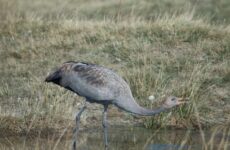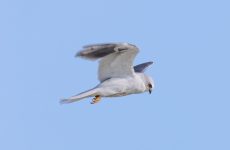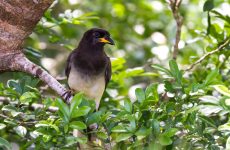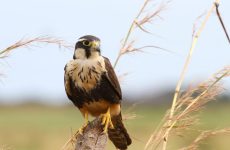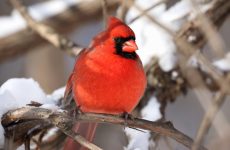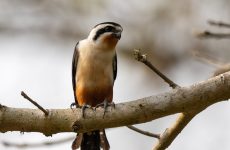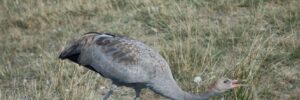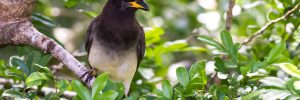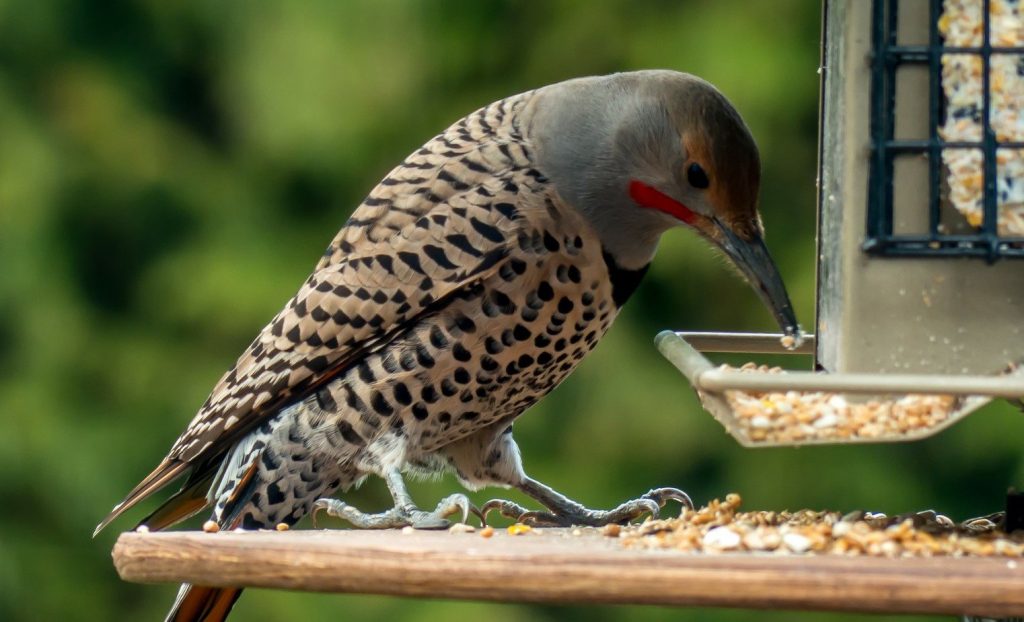
Brown birds or LBJ (little brown jobs) can be hard to identify as they do not always have as many distinguishing features as their brighter-colored cousins.
But fear not, as this guide will help you identify a sparrow, a wren, or any other brown bird you are likely to spot. Also, find out which brown birds are in Texas at different times of the year.
This guide will help you identify those brown birds visiting your backyard or out in the woods and fields and are listed from most to least common according to checklists submitted by bird watchers on ebird for Texas.
Brown Birds In Texas By Season
Brown Birds in Texas all year: Northern Cardinal, Mourning Dove, Carolina Wren, House Sparrow, Eastern Phoebe, House Finch, Bewick’s Wren, Common Yellowthroat, Brown Thrasher, Canyon Towhee
Brown Birds in Texas in summer: Brown-headed Cowbird, Great Crested Flycatcher
Brown Birds in Texas in winter: American Robin, Savannah Sparrow, American Goldfinch, Chipping Sparrow, Cedar Waxwing, White-crowned Sparrow, White-throated Sparrow, House Wren, Northern Flicker, Song Sparrow, Pine Siskin, Hermit Thrush, Spotted Towhee, Marsh Wren, Swamp Sparrow, Brown Creeper, Winter Wren, Eastern Towhee, Purple Finch, American Tree Sparrow
Brown Birds during migration in Texas: Swainson’s Thrush, Rose-breasted Grosbeak, Northern Waterthrush, Wood Thrush, Louisiana Waterthrush
Rare or accidental species in Texas: Golden-crowned Sparrow
38 Brown Birds In Texas
1. Northern Cardinal – Female
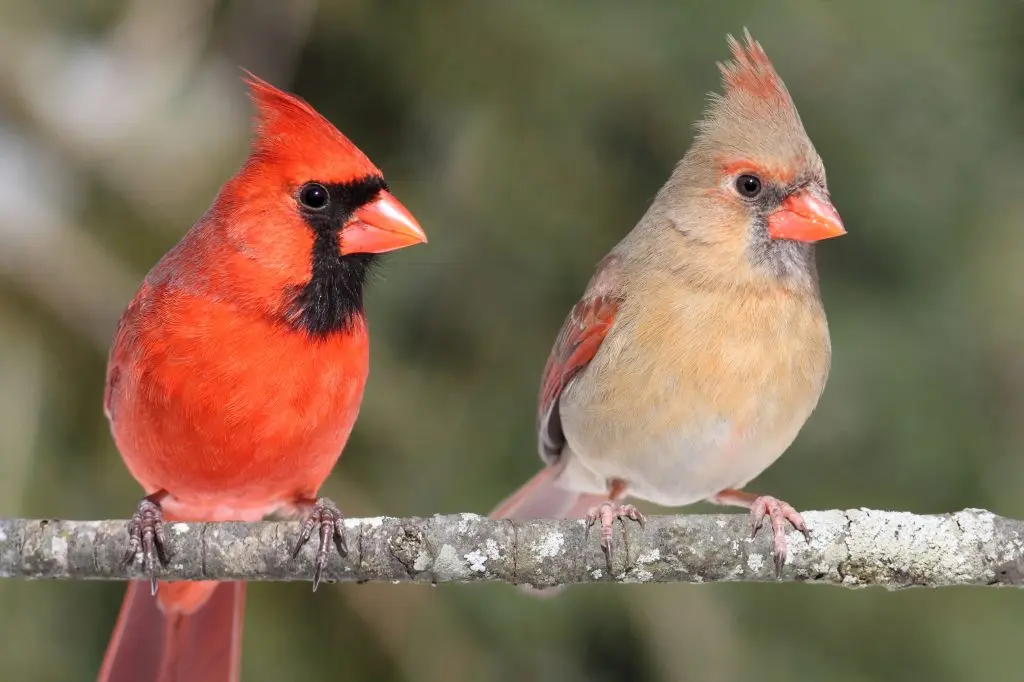
Northern Cardinals are frequently spotted in Texas all year. They are recorded in 55% of summer checklists and 48% of winter checklists submitted by bird watchers for the state.
Females Northern Cardinals are a little showy with their brown coloring, sharp brown crest, red highlights, and red beaks.
However, the bright red male Northern Cardinal with black around their faces is an incredible sight, especially against a white winter background. They also have red crests and beaks.
- Cardinalis cardinalis
- Length: 8.3-9.1 in (21-23 cm)
- Weight: 1.5-1.7 oz (42-48 g)
- Wingspan: 9.8-12.2 in (25-31 cm)
Northern Cardinals live in the eastern half of the US, and some states in the south as far west as Arizona.
You can find Northern Cardinals in dense vegetation foraging for seeds, fruit, and insects. Northern Cardinals sometimes attack their own reflection during the breeding season as they obsessively defend their territories.
Attract Northern Cardinals to your backyard with feeders full of sunflower seeds, peanut hearts, millet, and milo. They will feed from large tube feeders, hoppers, platform feeders, or food scattered on the ground.
2. Mourning Dove
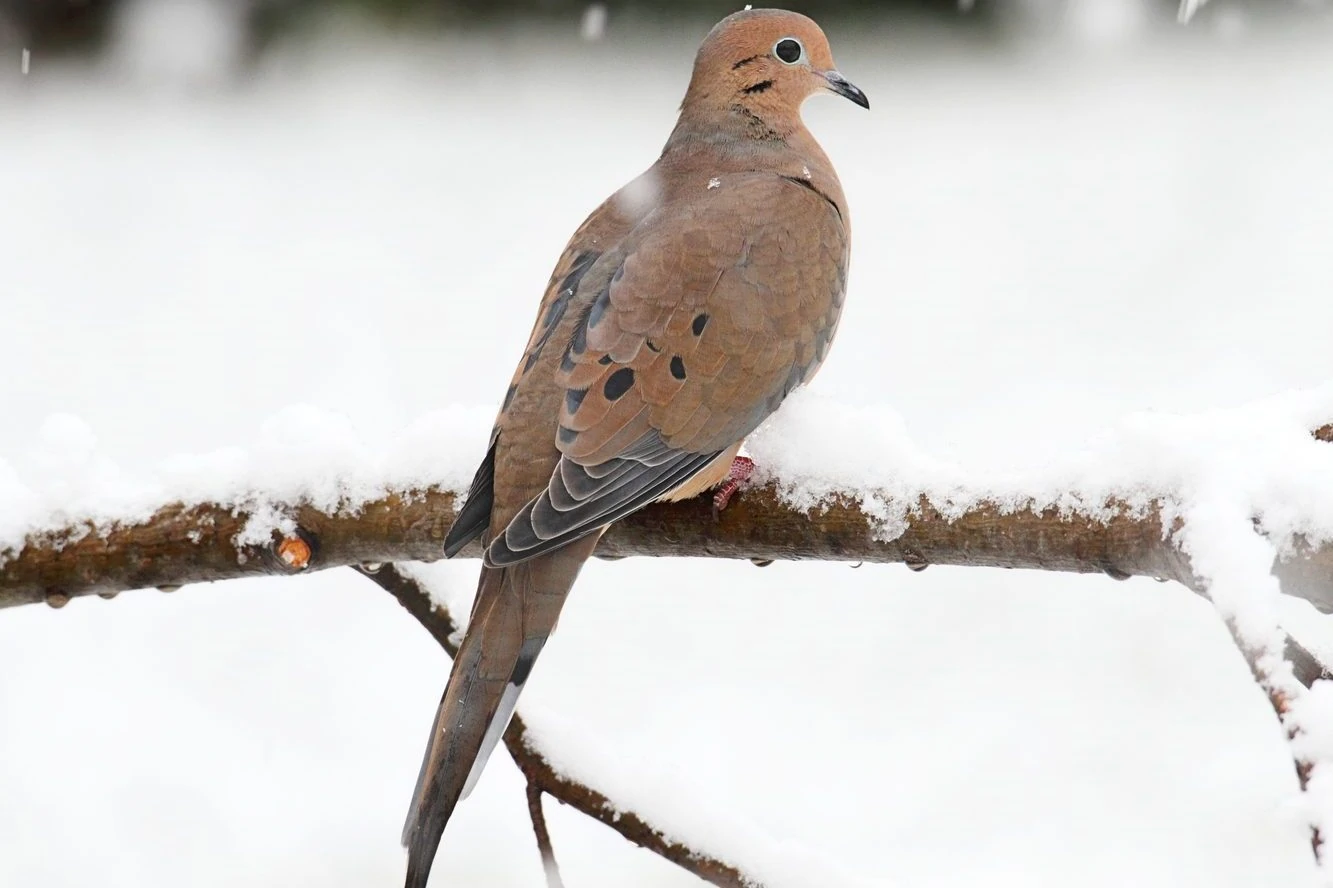
Mourning Doves are residents of Texas all year, but they are most common from May to September. They occur in 44% of summer checklists and 28% of winter checklists.
Mourning Doves are graceful small-headed birds with plump bodies and long tails. They are a soft brown color with black spots on the wings. Males are slightly heavier than females.
- Zenaida macroura
- Length: 9.1-13.4 in (23-34 cm)
- Weight: 3.0 -6.0 oz (96-170 g)
- Wingspan: 17.7 in (45 cm)
Mourning Doves are common over all of the lower 48 all year but may migrate after breeding from the north of the Midwest and southern Canada.
Mourning Doves can be seen perching on telephone wires and foraging for seeds on the ground in grasslands, fields, and backyards. They can also be found in open areas or woodland edges.
Attract Mourning Doves to your backyard by scattering millet on the ground or platform feeders. They will also eat black sunflower seeds, nyjer, cracked corn, and peanut hearts.
3. Carolina Wren
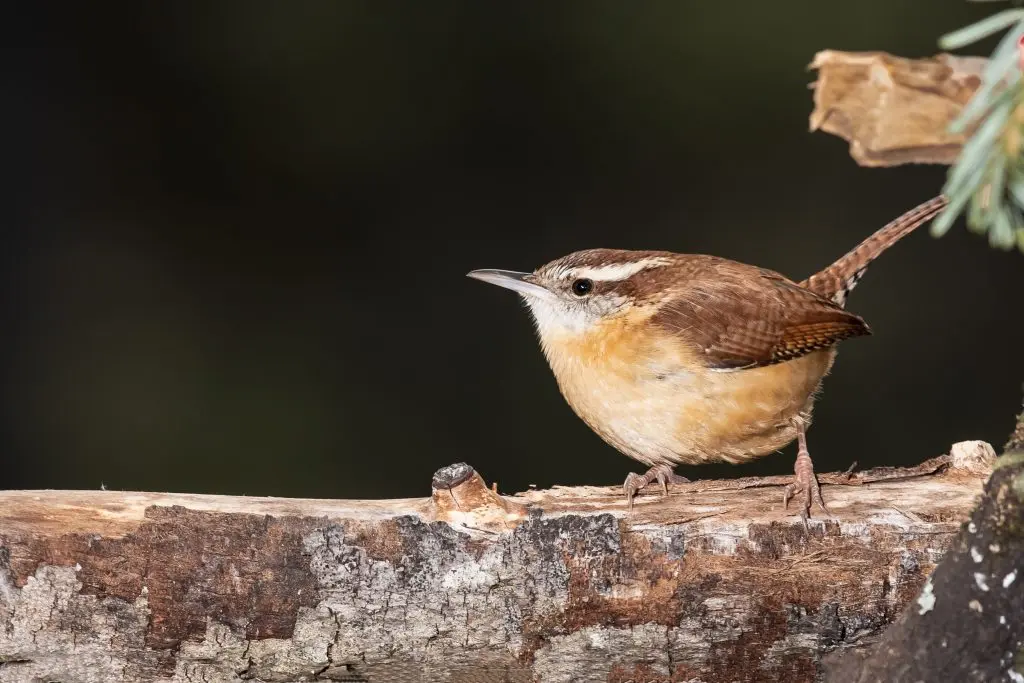
Carolina Wrens do not migrate and are frequently spotted in Texas all year. They appear in 28% of summer checklists and 24% of winter checklists.
Carolina Wrens are shy birds that are dark brown on top and light brown underneath. They have a white eyebrow stripe, upright tail, and a loud ‘teakettle‘ song.
- Thryothorus ludovicianus
- Length: 4.7-5.5 in (12-14 cm)
- Weight: 0.6-0.8 oz (18-22 g)
- Wingspan: 11.4 in (29 cm)
Carolina Wrens are residents all year across eastern and southeastern US States. You can find them in woods or thickly vegetated areas, and they will visit backyard feeders.
Attract Carolina Wrens to your backyard feeders with suet feeders, hulled sunflower seeds, or peanut hearts in large tube feeders or on platform feeders.
Some Wrens in Texas are pretty common in backyards, but to spot others, you will need to head out to marshy areas.
4. House Sparrow
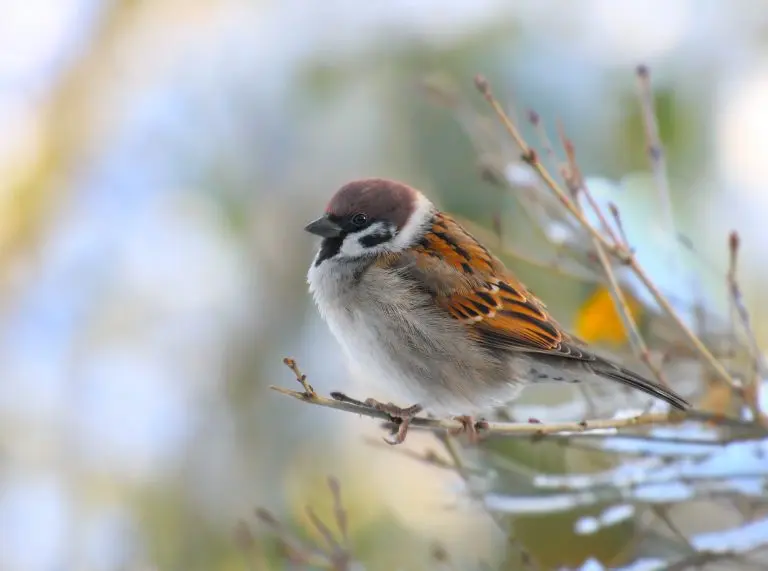
House Sparrows are an introduced species in Texas that can be spotted here all year. They do not migrate and occur in 28% of summer checklists and 21% of winter checklists.
House Sparrows are another introduced species that have done very well and are now one of the most common birds. They have gray and brown heads and white cheeks. Their backs are black and brown, and their bellies are gray.
- Passer domesticus
- Length: 5.9-6.7 in (15-17 cm)
- Weight: 0.9-1.1 oz (27-30 g)
- Wingspan: 7.5-9.8 in (19-25 cm)
House Sparrows live in the US and southern Canada all year. You can find them near houses and buildings, and they can be pretty tame, and they may even eat out of your hand.
House Sparrows eat mostly grain and seed as well as discarded food. They can be considered a pest because they are non-native, but they are found in backyards even if you do not feed them.
Attract House Sparrows to your backyard feeders with most kinds of birdseed, including millet, corn, and sunflower seeds.
5. Eastern Phoebe
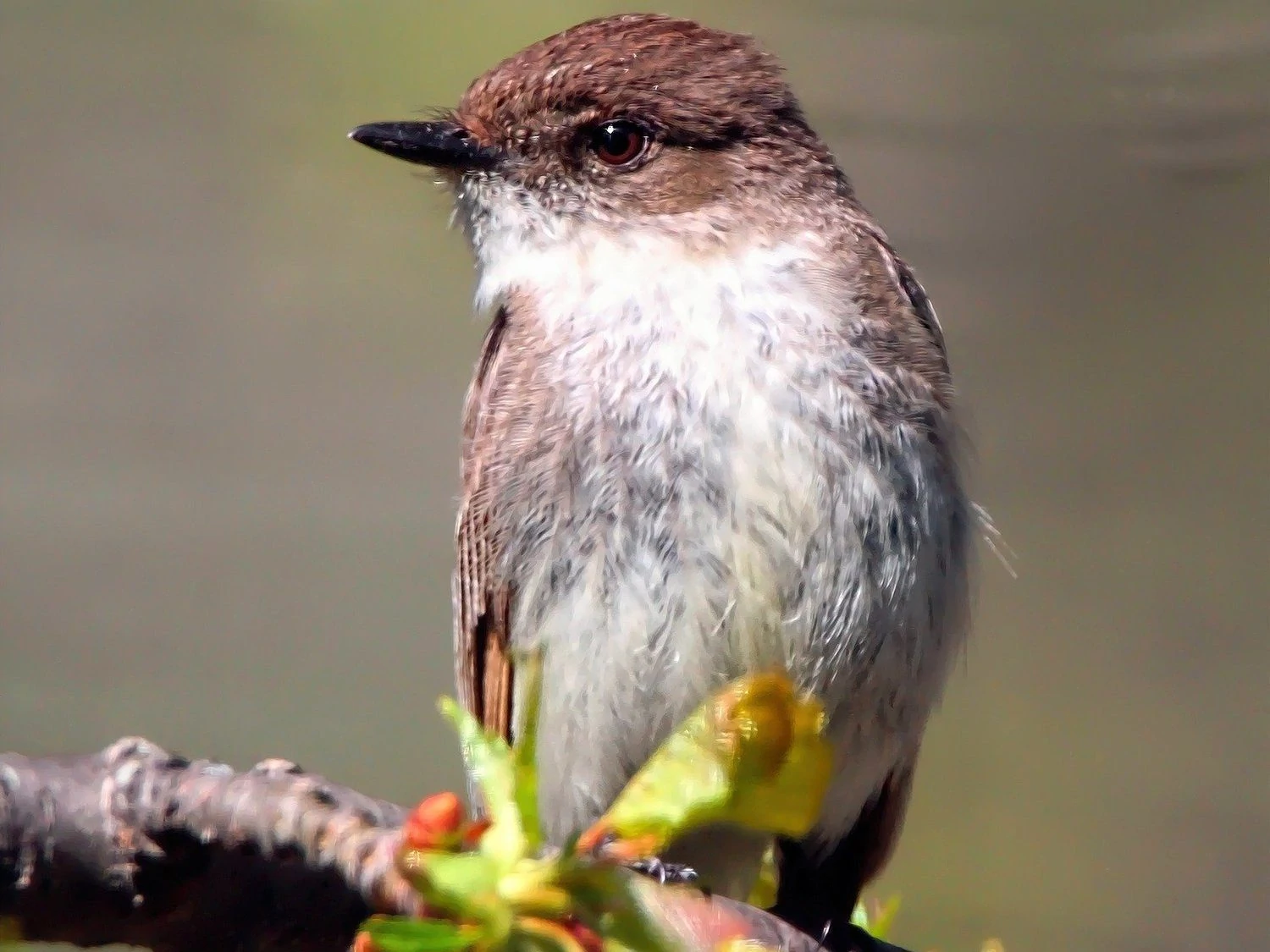
Eastern Phoebes are spotted all year in Texas but are more often seen during winter, from October to March, in the south of the state. They appear in 10% of summer checklists and 25% of winter checklists.
Eastern Phoebes are plump songbirds that are grayish-brown on the back, whitish underneath, and with a darker head.
- Sayornis phoebe
- Length: 5.5-6.7 in (14-17 cm)
- Weight: 0.6-0.7 oz (16-21 g)
- Wingspan: 10.2-11.0 in (26-28 cm)
Eastern Phoebes are migratory birds, breeding across northeastern and central US states and into Canada before migrating to southeastern US states and Mexico for winter. Some birds may remain all year towards the south of their range.
Eastern Phoebes tend to be found alone in quiet woodland, wagging their tails from low perches rather than in pairs or flocks.
As they are flycatchers, flying insects make up most of their diet, but they will also eat spiders and other insects, small fruit, and seeds. They often nest on bridges, barns, or houses, making a nest out of mud and grass.
Attract Eastern Phoebes to your backyard by putting up a nest box or native plants that produce berries.
6. House Finch – Female
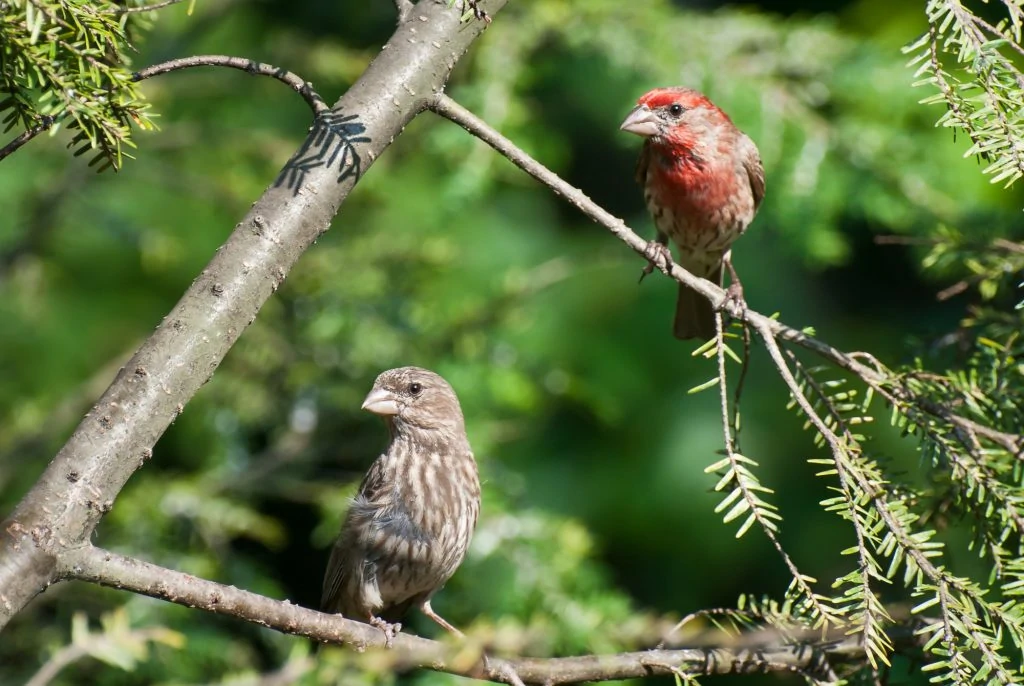
House Finches are residents of Texas all year. They do not migrate and appear in around 21% of summer checklists and 15% of winter checklists.
Females House Finches are brown-streaked all over, but Male House Finches have a red head and breast, and the rest of their bodies are mainly brown-streaked.
- Haemorhous mexicanus
- Length: 5.1-5.5 in (13-14 cm)
- Weight: 0.6-0.9 oz (16-27 g)
- Wingspan: 7.9-9.8 in (20-25 cm)
Originally only in western US states, House Finches were introduced to eastern US states and have done very well, even pushing out the Purple Finch.
They can be found in parks, farms, forest edges, and backyard feeders in noisy groups that are hard to miss.
Attract House Finches to backyard feeders with black oil sunflower seeds or nyjer seeds in tube feeders or platform feeders.
Not all finches in Texas are brown, some may be more brightly colored.
7. American Robin
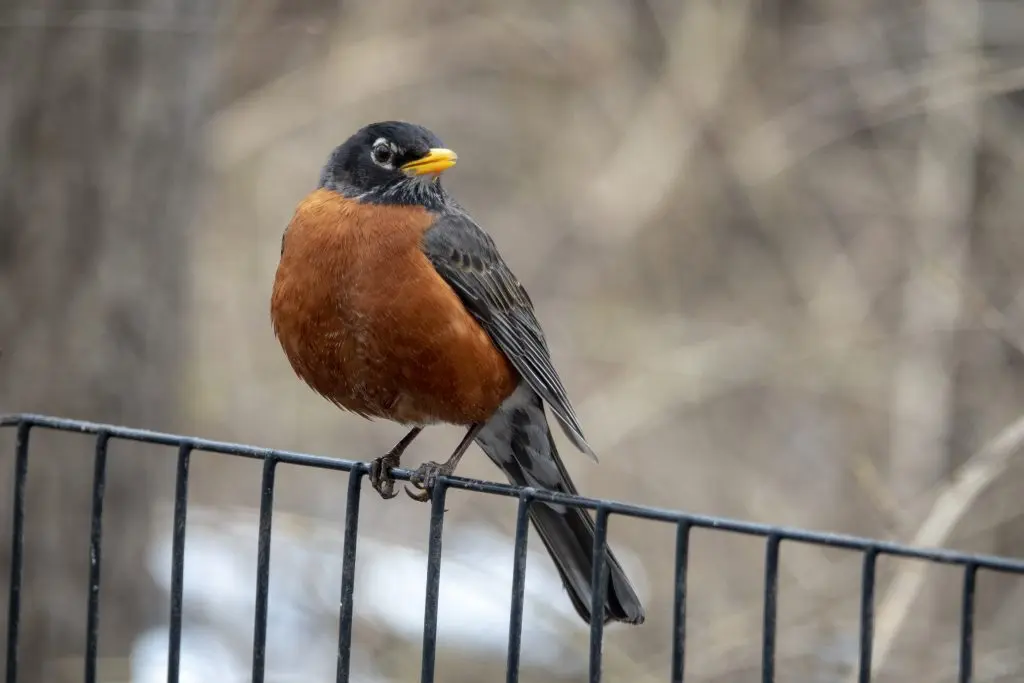
American Robins are spotted in Texas during winter from November to March, but some remain in the north of the state all year. They appear in 8% of summer checklists and 17% of winter checklists.
American Robins are a common sight on lawns eating earthworms. They have black heads and backs with red or orange breasts. They tend to roost in trees in winter, so you are more likely to see them in your backyard from spring.
- Turdus migratorius
- Length: 7.9-11.0 in (20-28 cm)
- Weight: 2.7-3.0 oz (77-85 g)
- Wingspan: 12.2-15.8 in (31-40 cm)
American Robins are residents in the lower 48 and the coast of western Canada and Alaska. Those that breed in Canada and inland Alaska move south for the winter.
American Robins can be found in many habitats, from woodlands, forests, and mountains to fields, parks, and lawns. They eat earthworms, insects, snails, and fruit.
Attract American Robins to your backyard with sunflower seeds, suet and peanut hearts, fruit, and mealworms. Platform feeders are best or food scattered on the ground. Also, try planting some native plants that produce berries, such as juniper, sumac, hawthorn, and dogwood.
8. Brown-headed Cowbird – Female
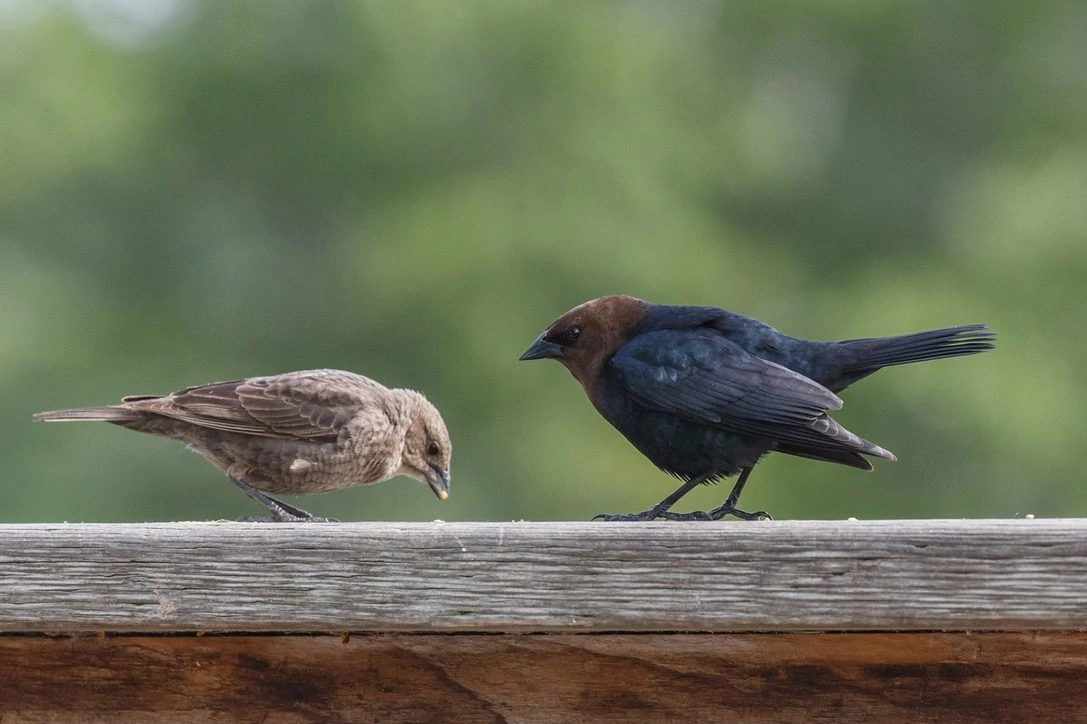
Brown-headed Cowbirds are frequently spotted in Texas from March to July, and appear in 17% of checklists at this time. However, some stay in the state all year and appear in 5% of winter checklists.
Female Brown-headed Cowbirds are brown all over with slight streaking. Male Brown-headed Cowbirds are larger than females, with black bodies, brown heads, and short tails.
- Molothrus ater
- Length: 76.3-8.7 in (19-22 cm)
- Weight: 1.3-1.8 oz (42-50 g)
- Wingspan: 14.2 in (36 cm)
Brown-headed Cowbirds remain all year in eastern US states, southern US states, and along the Pacific Coast. However, those that breed in northern and western US states and Canada migrate south for winter.
They are often considered a nuisance because they are parasite birds that destroy the eggs of smaller songbirds so they can lay their eggs in the nest and have the bird foster their chicks.
9. Bewick’s Wren
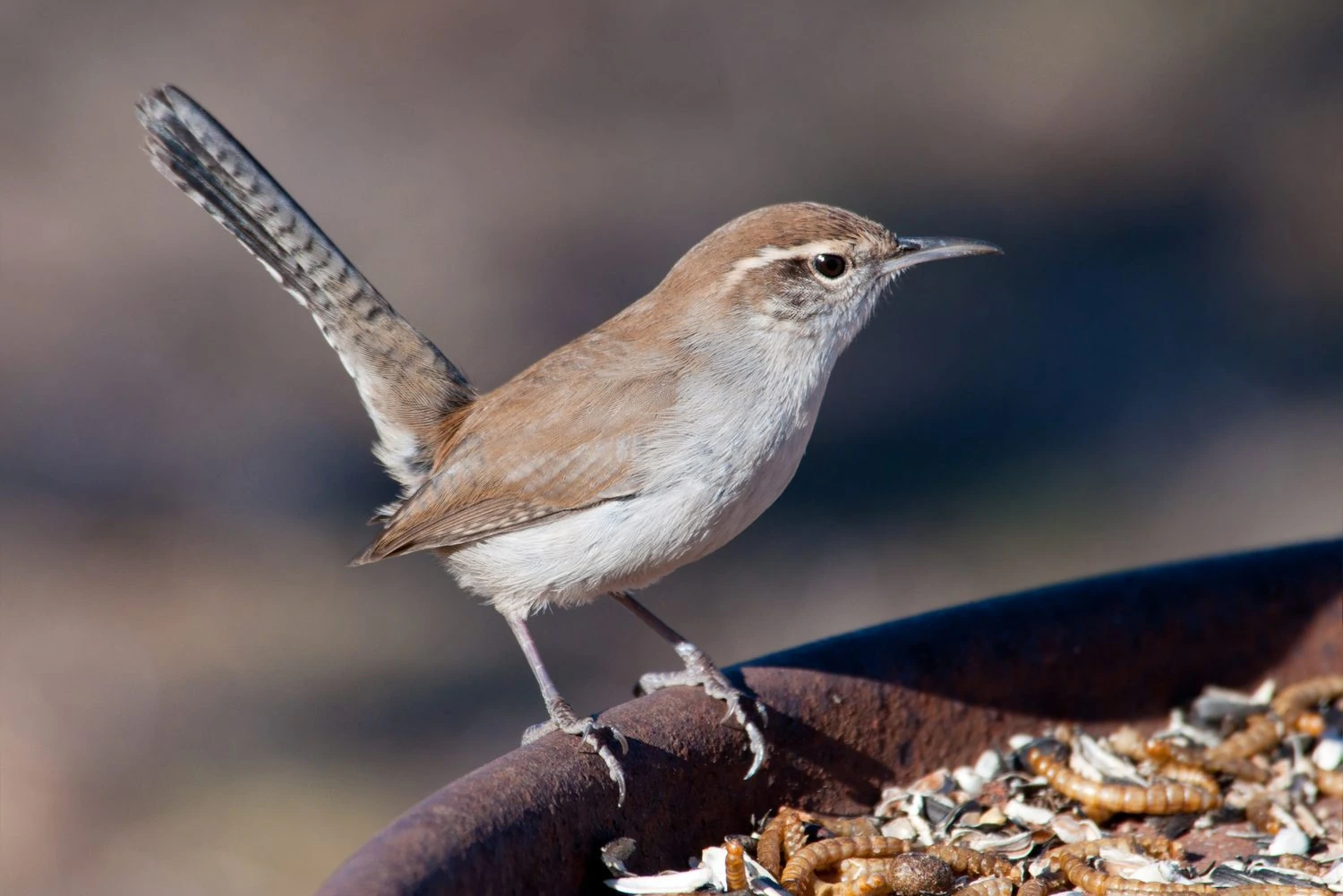
Bewick’s Wrens are frequently spotted in Texas all year. They appear in 12% of summer checklists and 8% of winter checklists.
Bewick’s Wrens are brown-backed birds with long gray upright tails with darker barring. They have gray bellies and a white stripe over the eye.
- Thryomanes bewickii
- Length: 5.1 in (13 cm)
- Weight: 0.3-0.4 oz (8-12 g)
Bewick’s Wrens live in southern and western states all year with some small movements in winter.
You can find Bewick’s Wrens in scrub, thickets, and open woodland, hopping from branch to branch, flicking their long tails. They feed on insects and larvae, including bees, bugs, caterpillars, and beetles.
Nests are on rock ledges, old woodpecker nests, nest boxes, or crevices in buildings. They are cup-shaped and made from sticks and grasses with a softer lining. Thye lay 3 – 8 eggs, and hatching takes around two weeks and fledging a further two weeks.
Attract Bewick Wrens to your backyard with suet, mealworms, and hulled sunflower seeds.
10. Savannah Sparrow
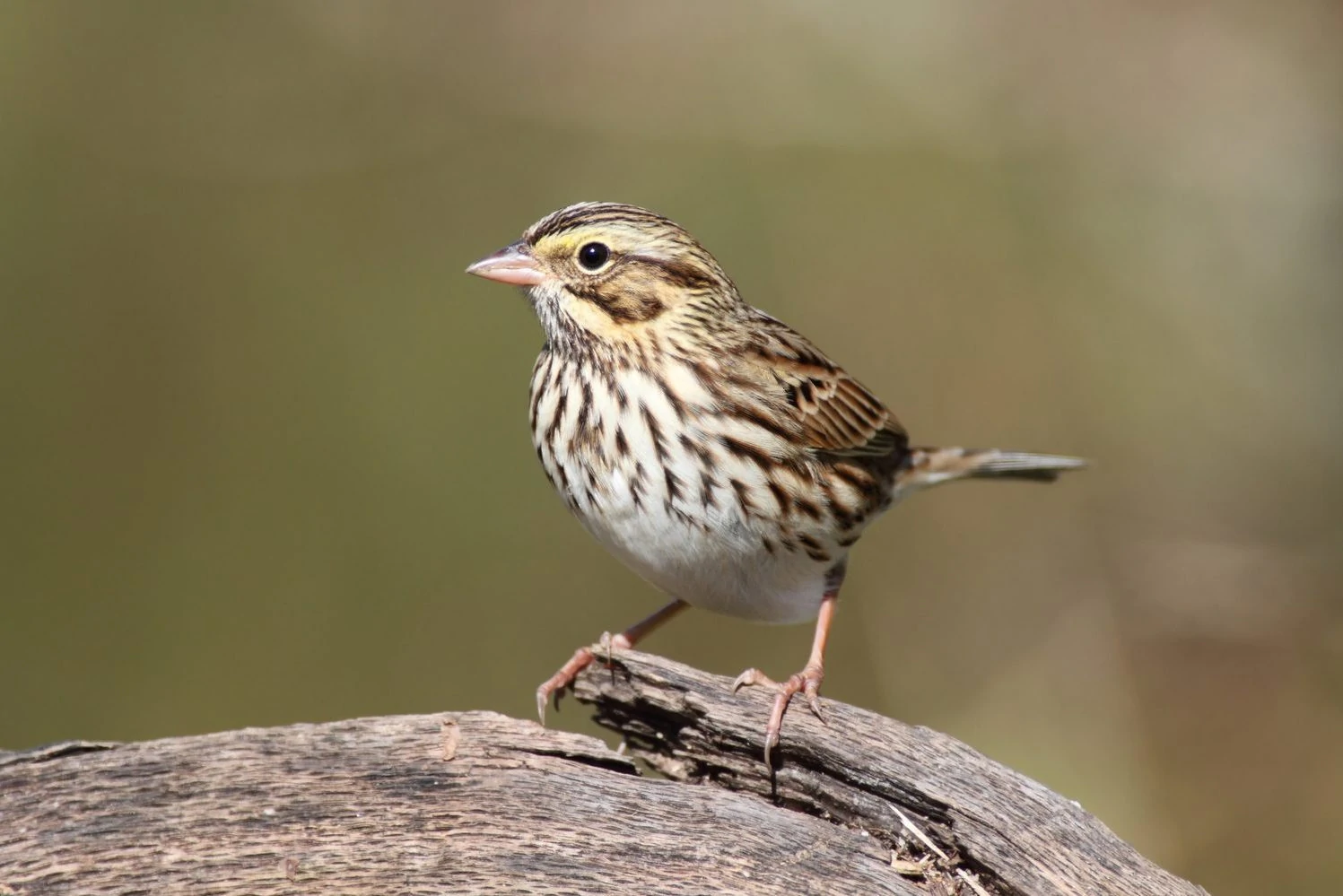
Savannah Sparrows are winter birds in Texas and occur in 13% of winter checklists. They are spotted here from late September to May.
11. American Goldfinch – Female
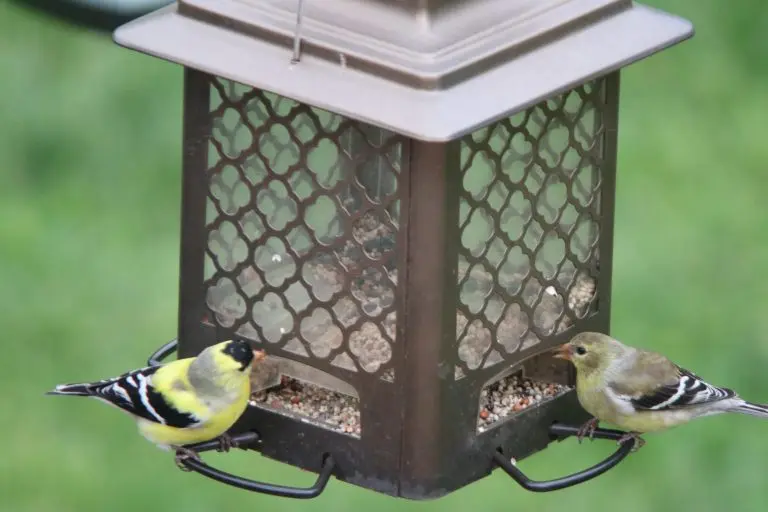
American Goldfinches are spotted in Texas during winter, and some stay in the north of the state all year. They are recorded in 19% of winter checklists submitted by bird watchers for the state.
American Goldfinches are popular birds with the males’ bright yellow and black coloring in spring. The females are duller brown, as are males in winter.
- Spinus tristis
- Length: 4.3-5.1 in (11-13 cm)
- Weight: 0.4-0.7 oz (11-20 g)
- Wingspan: 7.5-8.7 in (19-22 cm)
American Goldfinches can be found in most of North America and are usually resident all year. However, those that breed in Canada and the Midwest migrate to southern US States for winter.
They can be found in weedy fields and overgrown areas foraging for sunflower, thistle, and aster plants. They are also common in suburbs, parks, and backyards.
Attract American Goldfinches to your backyard by planting thistles and milkweed. They will visit most bird feeders and prefer sunflower seed and nyjer seed.
12. Chipping Sparrow
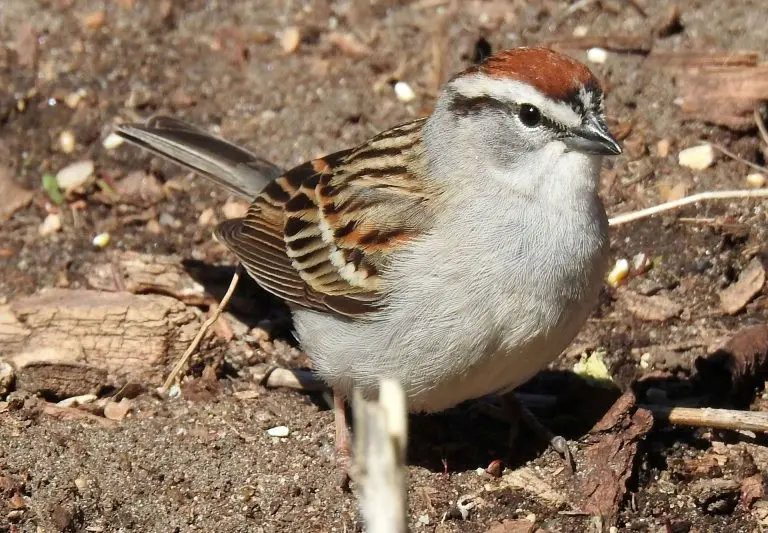
Chipping Sparrows are mainly spotted in Texas during winter, but some remain here all year. They are recorded in 3% of summer checklists and 12% of winter checklists.
Chipping Sparrows are slender, long-tailed birds with a grayish belly and brown and black-streaked back. They have a rusty crown and black eye line. In winter, their colors are more subdued.
- Spizella passerina
- Length: 4.7-5.9 in (12-15 cm)
- Weight: 0.4-0.6 oz (11-16 g)
- Wingspan: 8.3 in (21 cm)
Chipping Sparrows spend their summer breeding in the US and Canada before flying to Mexico and Florida for winter. Some remain all year in southern states.
You can find Chipping Sparrows in small flocks on open ground and will come to backyards for many kinds of birdseed.
Attract Chipping Sparrows to your backyard with seeds or cracked corn on open feeders such as hoppers or platforms.
13. Cedar Waxwing
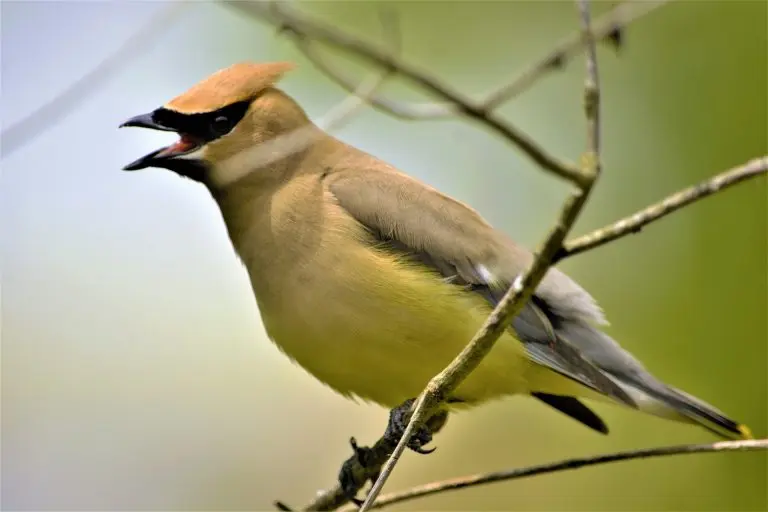
Cedar Waxwings are mainly seen in Texas during winter and occur in 12% of checklists at this time. They are usually spotted in the state from November until May.
Cedar Waxwings are elegant social birds that are pale brown on the head, chest, and crest, which fades to gray on the back, wings, and tail.
Their belly is pale yellow and bright yellow towards the tail. They have a narrow black mask over their eyes and bright red on the wingtips.
- Bombycilla cedrorum
- Length: 5.5-6.7 in (14-17 cm)
- Weight: 1.1 oz (32 g)
- Wingspan: 8.7-11.8 in (22-30 cm)
Cedar Waxwings remain all year in the northern half of the US. Those that breed in Canada migrate to the southern half of the US for winter.
They make a high-pitched call and can be found in berry bushes, woodlands, and streams.
Attract Cedar Waxwings to your backyard by planting native trees and shrubs with small fruit such as serviceberry, dogwood, juniper, winterberry, and hawthorn. You can also try fruit on platform feeders.
14. White-crowned Sparrow
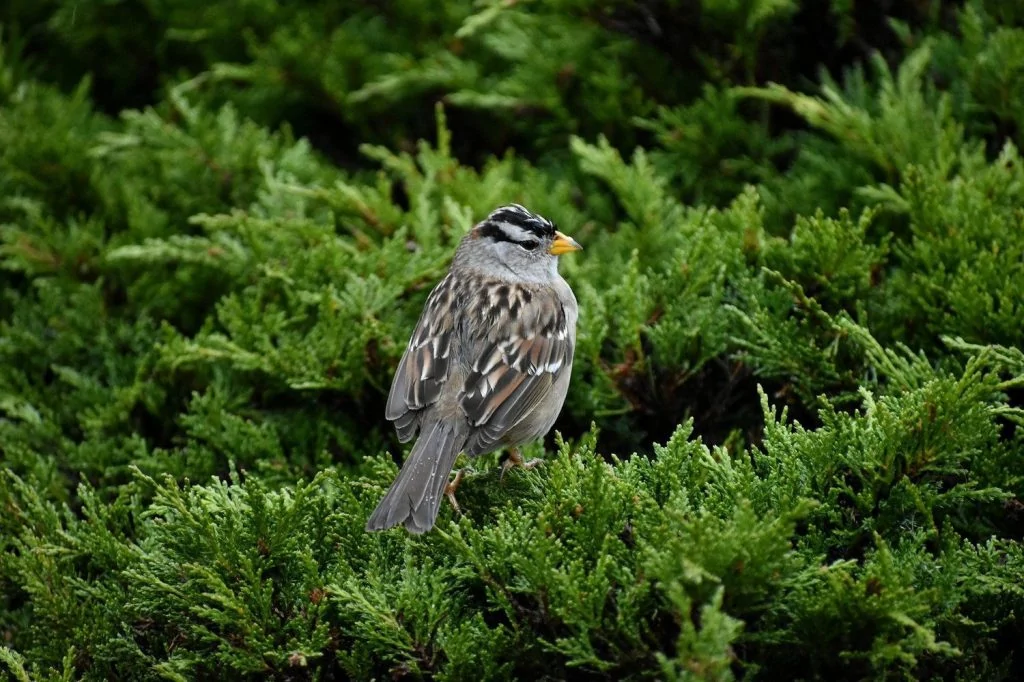
White-crowned Sparrows spend the winter in Texas and occur in 9% of checklists at this time. They are mainly spotted in the state from October until May.
White-crowned Sparrows are large grayish sparrows with long tails, small bills, and bold black and white stripes on their heads.
- Zonotrichia leucophrys
- Length: 5.9-6.3 in (15-16 cm)
- Weight: 0.9-1.0 oz (25-28 g)
- Wingspan: 8.3-9.4 in (21-24 cm)
White-crowned Sparrows breed in Alaska and arctic Canada before heading south to the lower 48 and Mexico for winter. However, some may remain along the Pacific Coast and the mountainous west all year.
You can find White-crowned Sparrows in weedy fields, along roadsides, forest edges, and in yards foraging for seeds of weeds and grasses or fruit such as elderberries and blackberries.
White-crowned Sparrow sounds: The males’ song is a clear whistle, followed by a series of chaotic whistles and finishing with a buzz. Calls are usually short and sharp. Females rarely call or sing.
Nests of White-crowned Sparrows are made from twigs, grass, moss, and pine needles, often low to the ground in shrubs or on the ground in the tundra. They lay up to seven eggs, which take up to two weeks to hatch and around nine days for the chicks to fledge.
Attract White-crowned Sparrows to your backyard with sunflower seeds, and they will also eat seeds dropped by other birds at the feeders.
Fun fact: Young White-crowned Sparrows take a further week or two to learn to fly after leaving the nest.
15. Common Yellowthroat
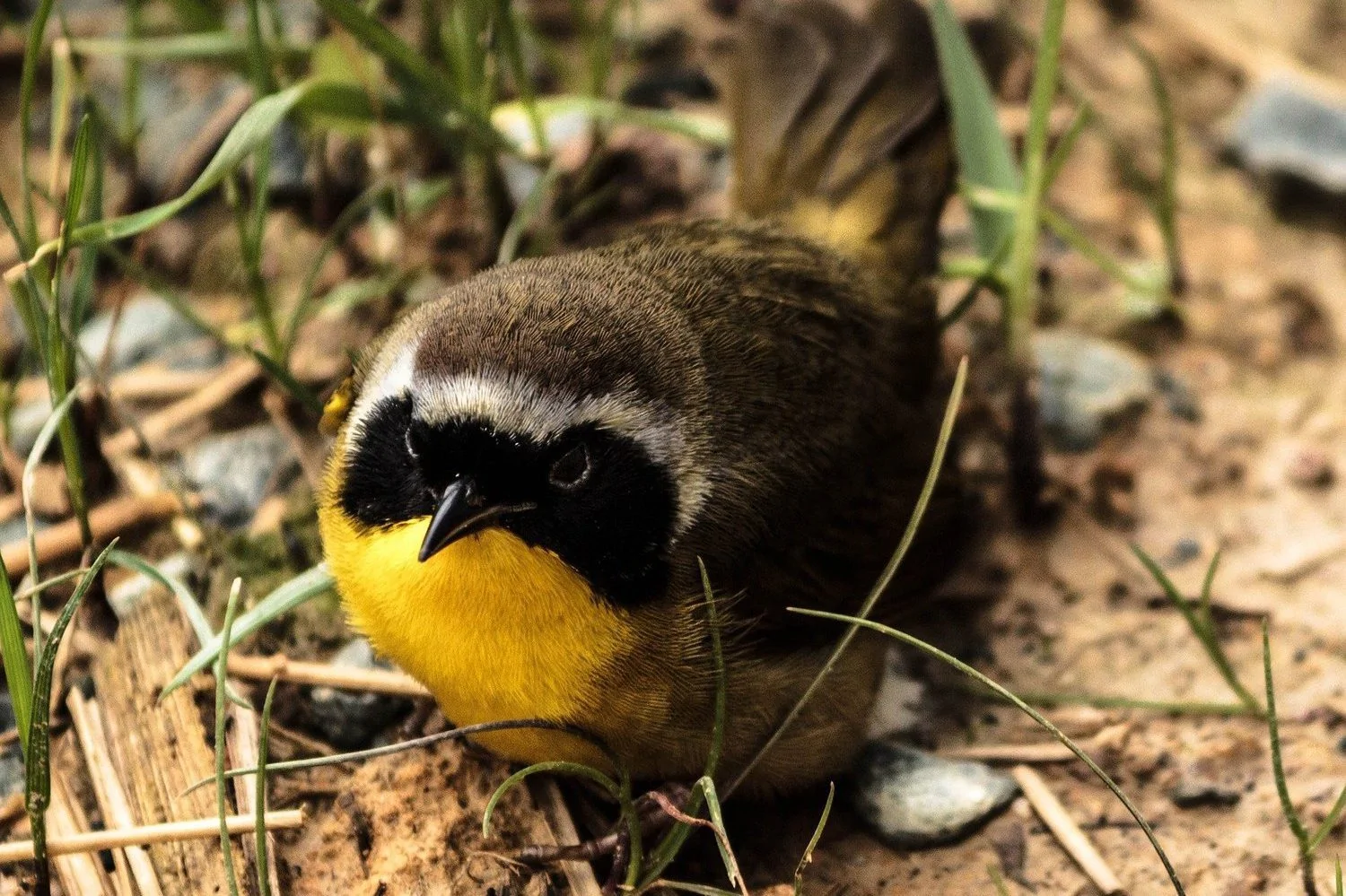
Common Yellowthroats can be spotted during summer in northern Texas, and they migrate to the south of the state for winter. They appear in 5% of summer and winter checklists for the state.
Common Yellowthroats are small songbirds that are brownish on the back and bright yellow underneath, with long tails. The males have black masks across their faces. The brightness of the yellow can vary geographically, and they may be more olive in parts underneath.
- Geothlypis trichas
- Length: 4.3-5.1 in (11-13 cm)
- Weight: 0.3-0.3 oz (9-10 g)
- Wingspan: 5.9-7.5 in (15-19 cm)
Common Yellowthroats spend the summer breeding over most of North America, except Alaska and northern Canada. Some remain all year along the Gulf Coast and Pacific Southwest. Then, they migrate south for winter.
You can find Common Yellowthroats often in marshy or wetland areas and brushy fields living in thick, tangled vegetation.
Attract Common Yellowthroats to large backyards with dense vegetation and native plants to attract insects.
Common Yellowthroats are a type of warbler that can be spotted in Texas, but there are so many more. They have mesmerizing songs that you can listen to and learn.
16. White-throated Sparrow
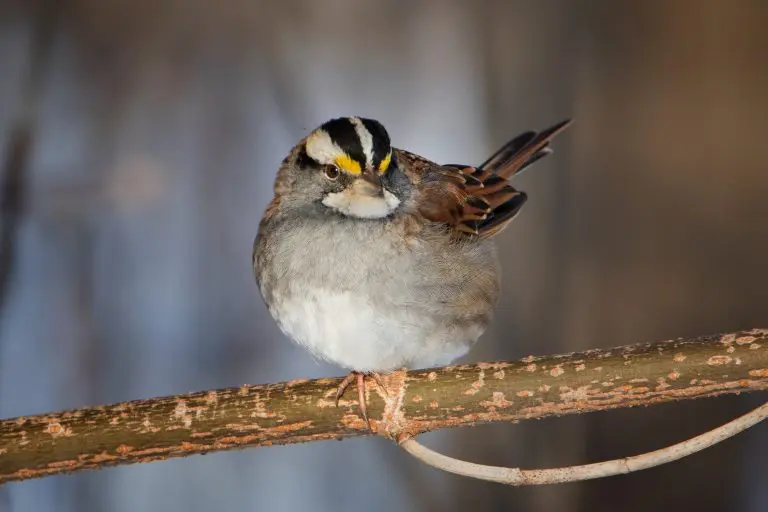
White-throated Sparrows are frequently spotted in Texas during winter and appear in 10% of winter checklists. They are mainly spotted here from October until April.
White-throated Sparrows have a distinctive black and white striped head, bright white throat, and yellow between the eye and bill. Their backs are brown, and underneath is gray.
- Zonotrichia albicollis
- Length: 6.3-7.1 in (16-18 cm)
- Weight: 0.8-1.1 oz (22-32 g)
- Wingspan: 7.9-9.1 in (20-23 cm)
White-throated Sparrows are migratory birds, breeding mainly in Canada before heading south in winter to eastern and southern US states and the Pacific Coast.
You can find White-throated Sparrows on the ground in forests and woods and along the edges of wooded areas, often in large flocks.
White-throated Sparrows’ diet is mainly seeds of grasses and weeds and fruits such as grape, sumac, mountain ash, blueberry, blackberry, and dogwood. They will also eat many insects from the forest floor, especially in summer.
Attract White-throated Sparrows to your backyard with millet and black oil sunflower seeds on platform feeders.
17. House Wren
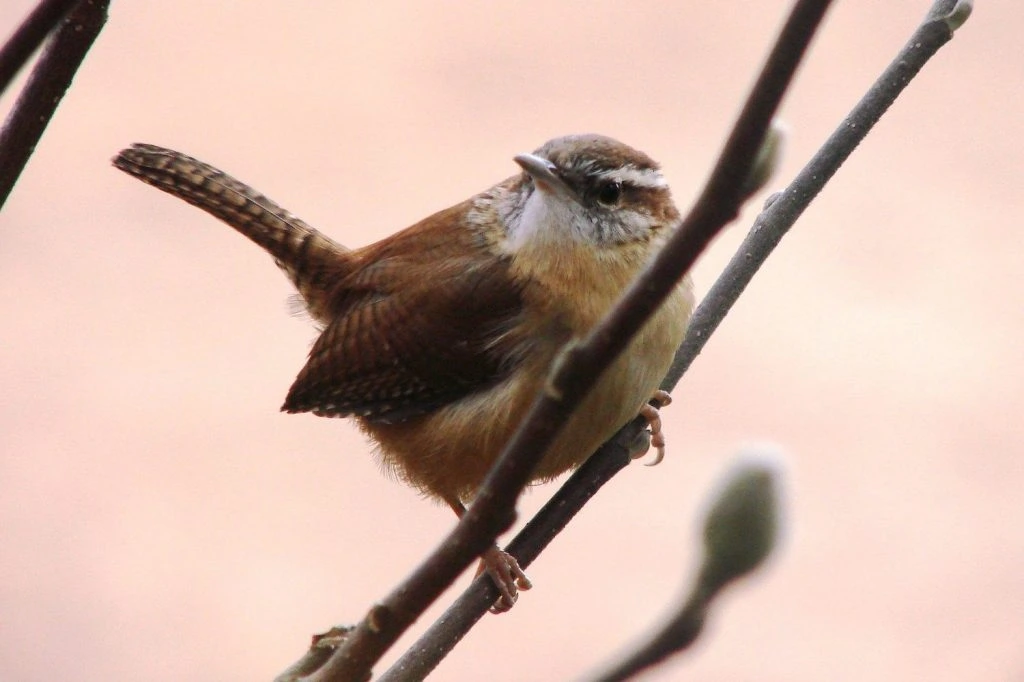
House Wrens are seen during winter in Texas and appear in 7% of winter checklists. Some can be spotted here all year, but October until mid-February are the best months to spot them.
House Wrens are small nondescript brown birds with darker barred wings and tails and a paler throat. They often have their tails standing up.
- Troglodytes aedon
- Length: 4.3-5.1 in (11-13 cm)
- Weight: 0.3-0.4 oz (10-12 g)
- Wingspan: 5.9 in (15 cm)
House Wrens spend their summer breeding in the US and southern Canada before migrating to southern US states and Mexico for winter.
You can find House Wrens in backyards, parks and open woods foraging for insects and spiders. They can often be found energetically hopping through tangles and low branches with their tails up, stopping to sing their cheerful song.
House Wrens are fierce for their size when it comes to getting the best nest holes. They will often harass larger birds, sometimes dragging eggs or nestlings out of a nest site they want.
Attract House Wrens to your backyard by leaving piles of brush or putting up a nest box.
18. Northern Flicker
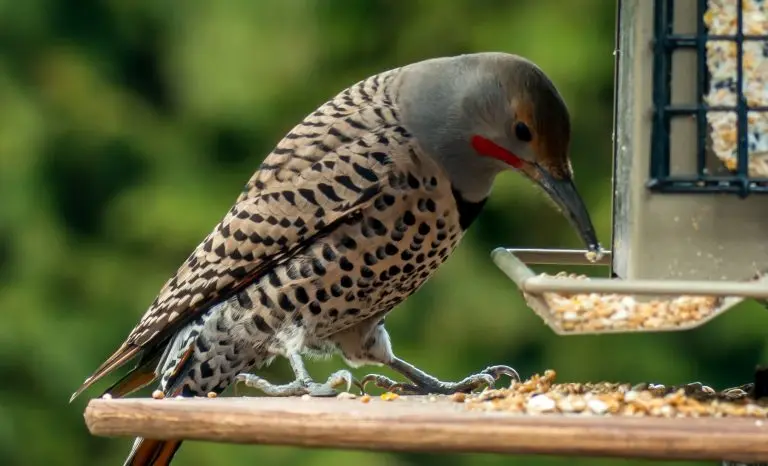
Northern Flickers can be found all year in the northeast of the state and in winter over most of Texas. They appear in 7% of winter checklists.
Northern Flickers are large brown woodpeckers with black spots and a white patch on their rump in flight, plus a red nape of the neck in the males.
Northern Flickers have red or yellow flashes in the wings and tail depending on where they originate. Red-shafted birds live in the west, and yellow-shafted birds live in the east.
- Colaptes auratus
- Length: 11.0-12.2 in (28-31 cm)
- Weight: 3.9-5.6 oz (110-160 g)
- Wingspan: 16.5-20.1 in (42-51 cm)
Northern Flickers can be spotted across the US all year and in Canada during summer. Those that breed in Canada migrate south for the winter.
Northern Flickers mainly eat ants, beetles, fruits, and seeds, and they can often be seen on the ground digging with their curved bill.
Attract Northern Flickers to your backyard with suet. You can also find other species of woodpeckers in Texas that will visit your feeders.
19. Song Sparrow
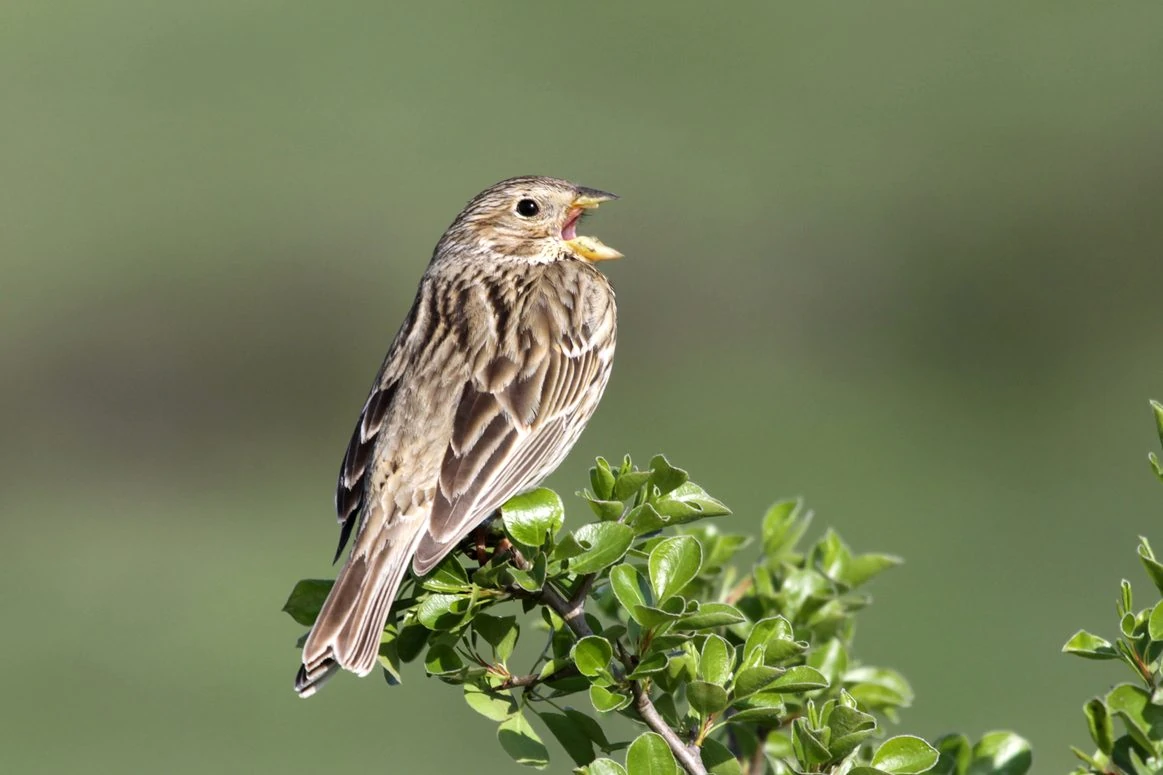
Song Sparrows are winter birds in Texas, and they start arriving in September and some stay until May, but October until April are the best months to spot them. They are recorded in 8% of winter checklists.
Song sparrows are not as remarkable looking as other backyard birds, but these predominantly brown-streaked birds use their almost constant song to attract mates in spring and summer.
- Melospiza melodia
- Length: 4.7-6.7 in (12-17 cm)
- Weight: 0.4-1.9 oz (12-53 g)
- Wingspan: 7.1-9.4 in (18-24 cm)
Song Sparrows live all year in the northern US states. Those that breed in Canada migrate to southern US states for winter.
They can be found in open, shrubby, and wet areas, often perched on a low shrub singing, and are often found at backyard feeders.
Song Sparrows eat a wide variety of insects and plants, including beetles, caterpillars, midges, spiders, and earthworms. They will also eat buckwheat, sunflower, raspberries, wild cherries, blackberries, wheat, and rice.
Attract Song Sparrows to your backyard feeders by putting black oil sunflower seeds, cracked corn, and nyjer on platform feeders.
A surprising number of sparrows in Texas can be spotted, and you can learn their songs and find out fun facts to help you identify them more easily.
20. Great-crested Flycatcher
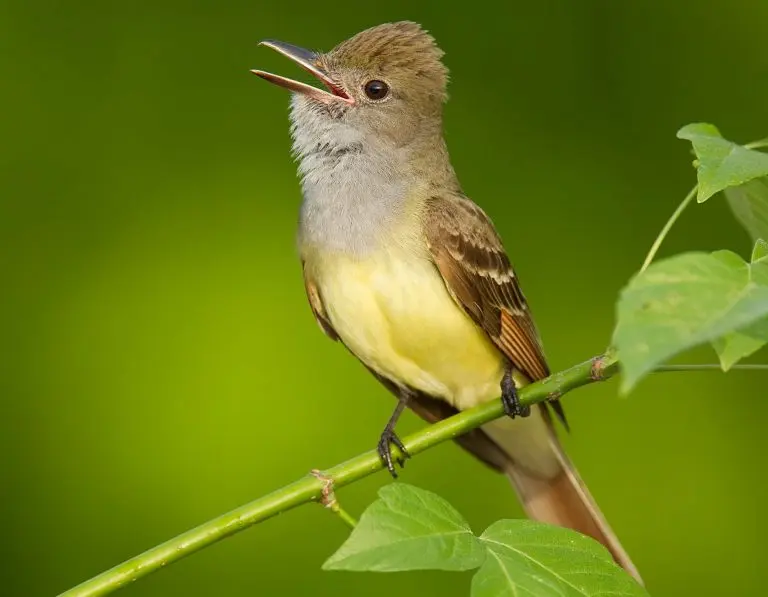
Great Crested Flycatchers spend the breeding season in Texas from April to September, but some hang around all year. They are recorded in 9% of summer checklists.
Great Crested Flycatchers are brown on the back with a yellow belly and gray throat. They have reddish flashes in the wing and tail feathers. The crest is not very obvious.
- Myiarchus crinitus
- Length: 6.7-8.3 in (17-21 cm)
- Weight: 0.9-1.4 oz (27-40 g)
- Wingspan: 13.4 in (34 cm)
Great Crested Flycatchers breed over much of eastern North America and spend the winter in southern Florida, southern Mexico, and Central America.
They sit perched up high in woodland, waiting for large insects flying, such as butterflies, grasshoppers, moths, wasps, and spiders. They can be found in mixed woodlands and at the edges of clearings, parks, and tree-lined neighborhoods or perched on fenceposts or other artificial structures. They will also eat berries and small fruit.
Attract Great Crested Flycatchers to your backyard by planting native species of plants and leaving brush piles to attract insects. Also, plant berry-producing plants and put up a nest box as they readily take up residence in them.
21. Brown Thrasher
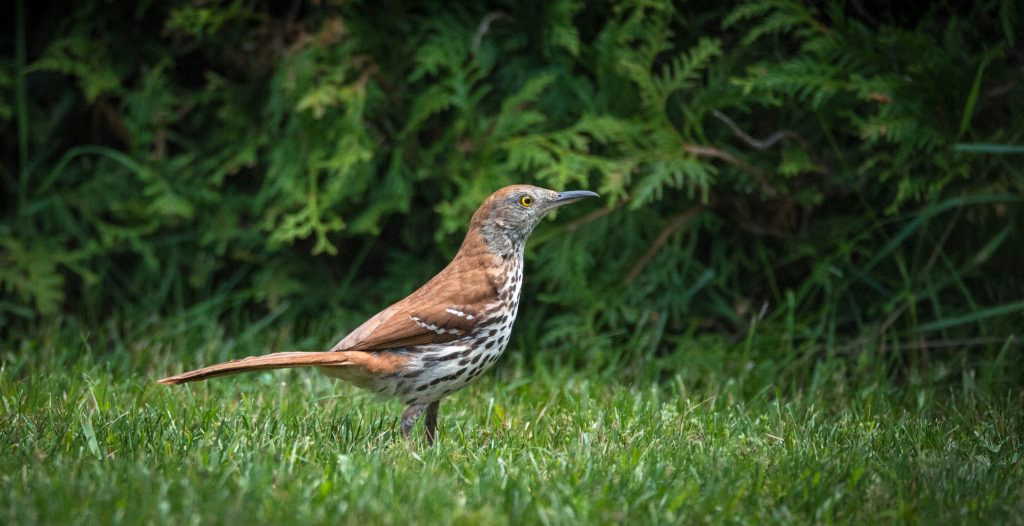
Brown Thrashers are spotted in Texas all year. They occur in up to 2% of summer and winter checklists.
Brown Thrashers are large songbirds with long proportions. They are about the same size as a robin. They are brown on the back and with white-streaked chests and bellies. Their faces are gray with bright yellow eyes.
- Toxostoma rufum
- Length: 9.1-11.8 in (23-30 cm)
- Weight: 2.1-3.1 oz (61-89 g)
- Wingspan: 11.4-12.6 in (29-32 cm)
Brown Thrashers live in central and eastern North America. Those birds in the southeast of their range remain all year, but birds further north migrate south for the winter.
Brown Thrashers are hard to spot for their size as they spend most of their time in thickets and shrubbery. However, they can be heard rummaging along the ground in the leaf litter and soil, looking for insects, but they also eat berries, beetles, and flying insects from the air.
Over 1000 different song types are sung by these most accomplished songbirds, which is one of the largest of any North American songbird.
Attract Brown Thrashers to your backyard with dense cover and berry shrubs, and they will collect fallen seeds from under feeders.
22. Pine Siskin
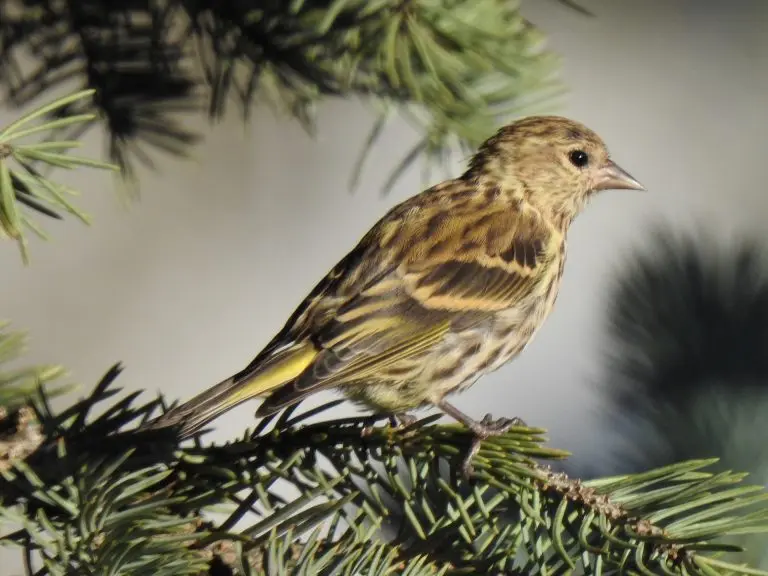
Pine Siskins mainly spend winter in Texas and are spotted from October to May. They are recorded in 5% of winter checklists.
Pine Siskins are small brown finches with yellow streaks on the wing and tail. They have a forked tail and pointed wings, with a short pointed bill.
- Spinus Pinus
- Length: 4.3-5.5 in (11-14 cm)
- Weight: 0.4-0.6 oz (12-18 g)
- Wingspan: 7.1-8.7 in (18-22 cm)
Pine Siskins remain all year in the pine forests in the western states and along the Canadian Border. Some also breed in Canada before heading south for winter.
Depending on pine cone crops, they can be found over much of North America. As their name suggests, Pine Siskins predominantly eat seeds from conifers, but they also eat young buds and seeds from grasses and weeds.
Attract Pine Siskins to your backyards with thistle and nyjer feeders, and will also come for black oil sunflower seeds and suet.
23. Hermit Thrush
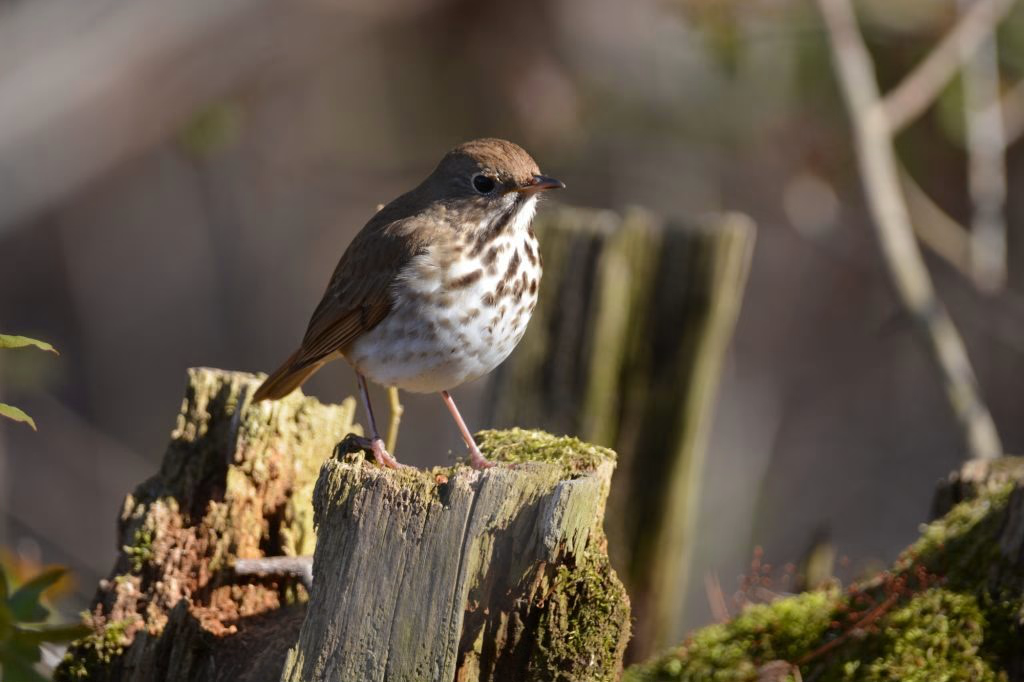
Hermit Thrushes spend winter in Texas and occur in 5% of checklists at this time. They are mainly spotted from October to May.
Hermit Thrushes are birds that stand to attention, with an upright manner, chunky bodies, and long tails. They are brown on the back and white underneath, with spots on the throat and breast.
- Catharus guttatus
- Length: 5.5-7.1 in (14-18 cm)
- Weight: 0.8-1.3 oz (23-37 g)
- Wingspan: 9.8-11.4 in (25-29 cm)
Hermit Thrushes breed in Canada, northeast US states, and the western US. They can be seen during migration in central states before spending winter along the Pacific Coast, southeast states, and Mexico.
Hermit Thrushes forage on the ground in forest clearings in the leaf litter, looking for insects. In winter, they also eat berries.
They rarely visit backyards, but their somewhat forlorn song can be heard in spring and summer.
24. Spotted Towhee
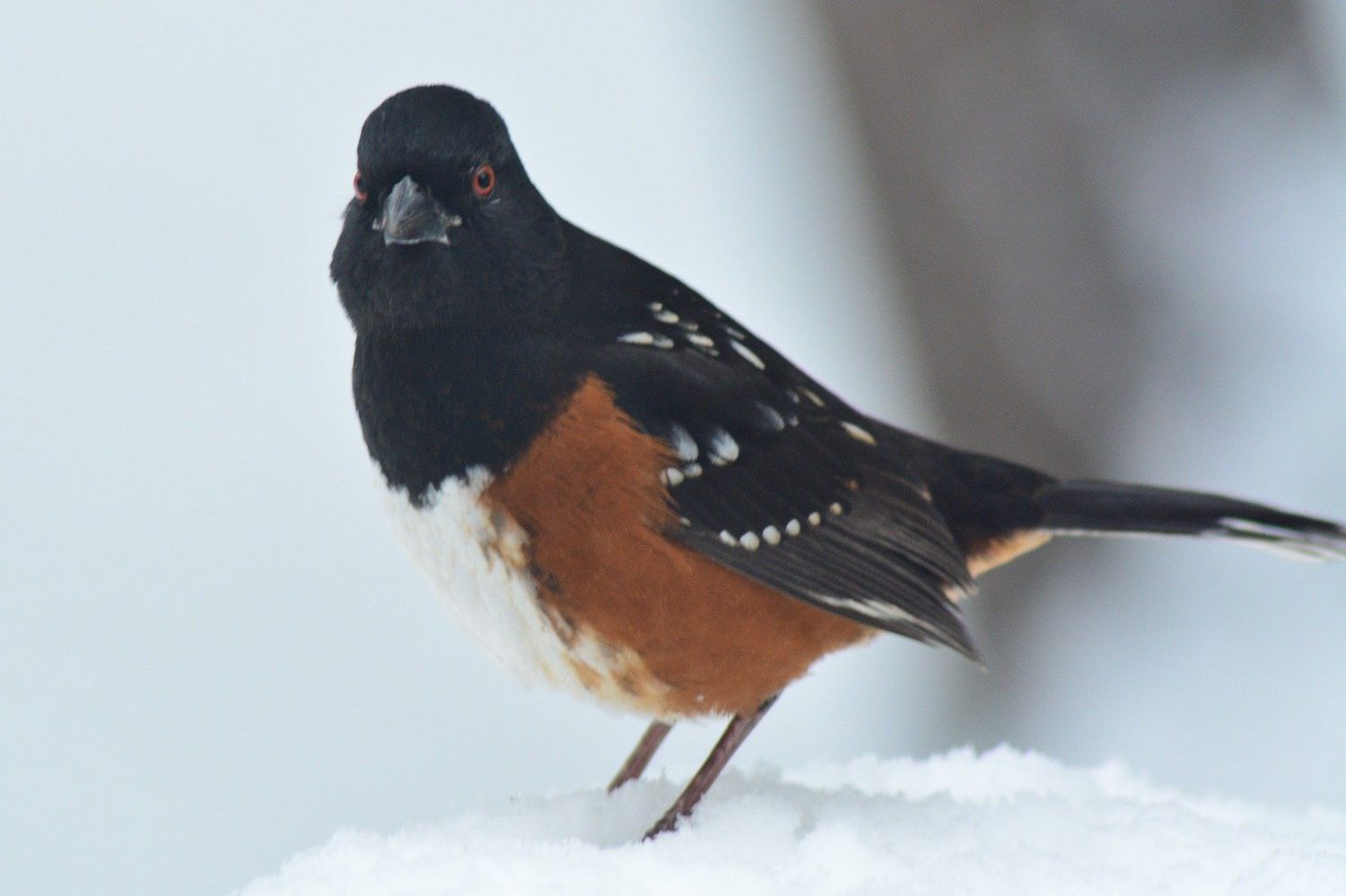
Spotted Towhees spend the winter in Texas and are recorded in 4% of checklists at this time. However, some stay in the state all year.
Spotted Towhees are large sparrows that are black on the head, throat, and back in the males and brown in the females. Both males and females have reddish-brown sides and white bellies, with white spots on their wings and back and long tails.
- Pipilo maculatus
- Length: 6.7-8.3 in (17-21 cm)
- Weight: 1.2-1.7 oz (33-49 g)
- Wingspan: 11.0 in (28 cm)
Spotted Towhees live in western US states, but those inland in the north migrate south to Texas after breeding.
Spotted Towhees can be found on the ground in dense tangles of shrubs scratching around for insects, including beetles, crickets, grasshoppers, caterpillars, wasps, and bees. They also eat acorns, berries, and seeds.
Spotted Towhee sounds: Songs are short notes followed by fast trills.
Nests of Spotted Towhees are usually on or near the ground and made from leaves, stems, and bark lined with softer material. They lay up to six eggs, which take around two weeks to hatch and a further ten days for the young to fledge.
Attract Spotted Towhees to your yard if you leave overgrown borders, and they will visit platform feeders or ground feeders for Black Oil Sunflower seeds, Hulled Sunflower seeds, Cracked Corn, Millet, and Milo.
Fun fact: Spotted Towhee males spend most of their mornings singing when trying to attract a mate.
25. Marsh Wren
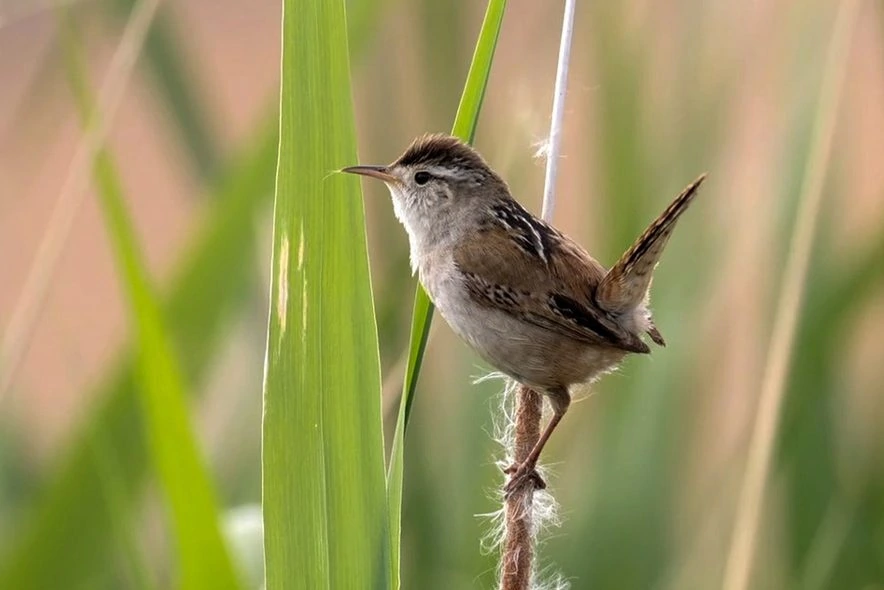
Marsh Wrens can be spotted during winter in Texas and are recorded in 2% of winter checklists. Although a few can be spotted all year, they are more common from September to May.
Marsh Wrens are brown with black and white streaks on their back. Their underside is grayish brown, and they have the distinctive upright tail of the wren. Males and females look the same.
They look similar but lack stripes on their shoulders and have longer bills than Sedge Wrens.
- Cistothorus palustris
- Length: 3.9-5.5 in (10-14 cm)
- Weight: 0.3-0.5 oz (9-14 g)
- Wingspan: 5.9 in (15 cm)
Marsh Wrens breed in northern US states and Central Canada before migrating to southern states and Mexico. Some birds in the west and along the Atlantic Coast may remain resident all year. They can be spotted during migration in the eastern US.
You can find Marsh Wrens in wetlands clinging to reeds, with each foot grabbing a different stalk. They can be hard to spot but listen out for singing amongst the reeds, especially at dawn and dusk. They eat insects and spiders, which they pick off leaves close to the water.
Nests of Marsh Wrens are fully enclosed, except for a small opening in the top. They are made from reeds and grasses woven together.
26. Swamp Sparrow
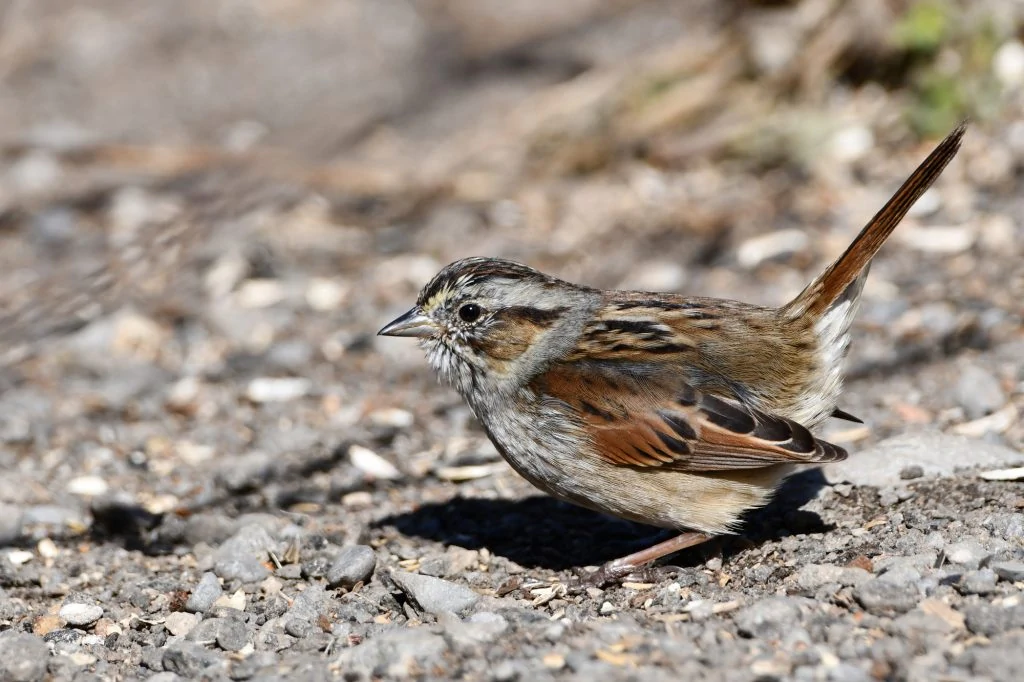
Swamp Sparrows spend the winter in Texas and can be seen from September until May. They appear in 4% of winter checklists.
Swamp Sparrows are dark brown on the back with rusty crowns and wings. They have gray breasts and white throats. Their heads are gray, with brown faces with a dark eye line and a yellow end to their beak.
- Melospiza georgiana
- Length: 4.7-5.9 in (12-15 cm)
- Weight: 0.5-0.8 oz (15-23 g)
- Wingspan: 7.1-7.5 in (18-19 cm)
Swamp Sparrows are located more in the east. They breed in Canada, northeastern US states, and North Central US states before migrating to eastern and southern US states and Mexico.
As the name would suggest, Swamp Sparrows are found in wetlands, swamps, bogs, and coastal marshes. They feed on seeds and fruit, especially in winter, and more insects in spring.
Nests of Swamp Sparrows are usually hidden in vegetation on or close to the ground and made from twigs, leaves, and cattails. The nest is lined with grass and other plant material.
Swamp Sparrows do not visit backyards except in migration to yards with lots of vegetation and water.
27. Swainson’s Thrush
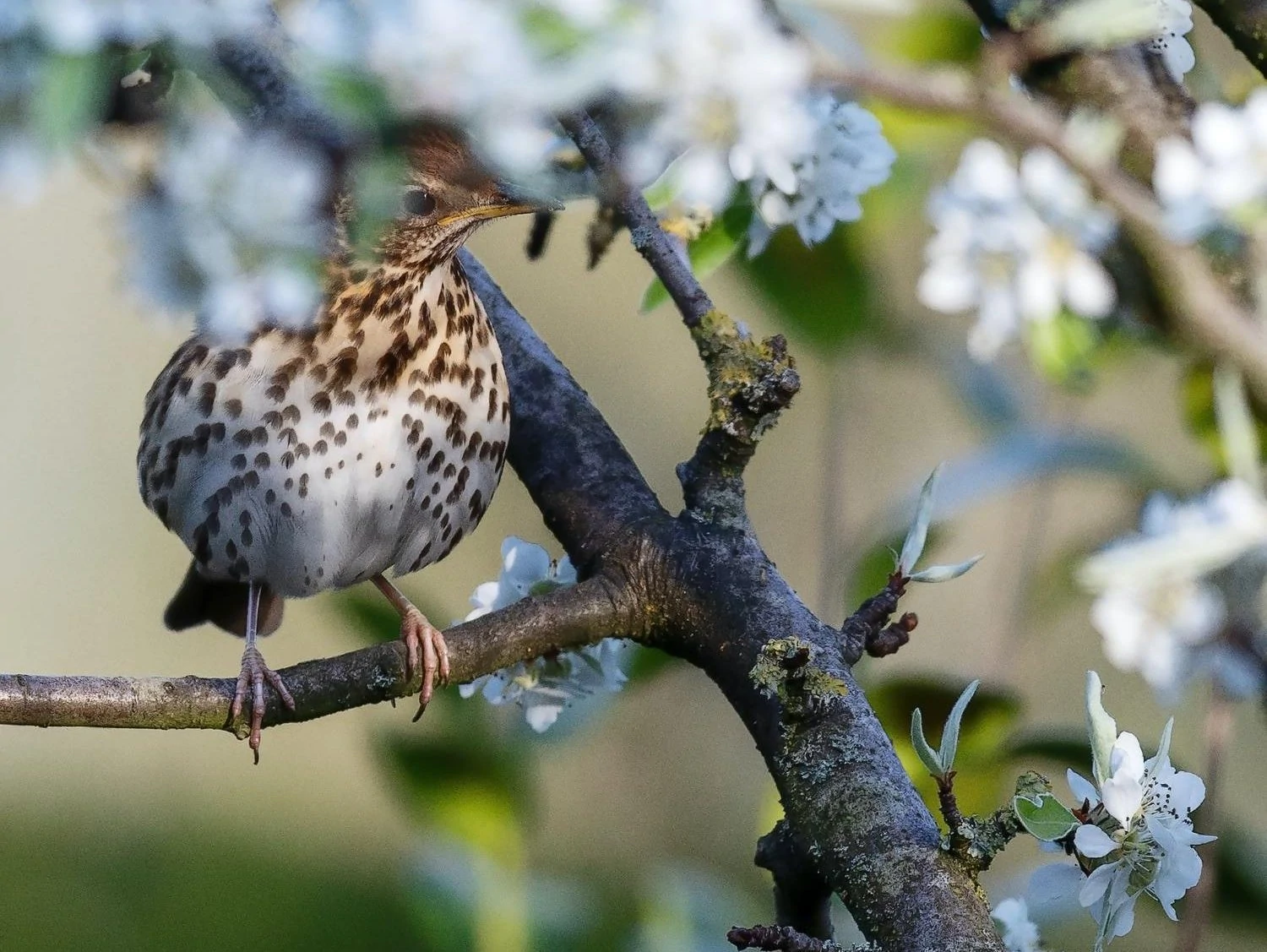
Swainson’s Thrushes are spotted in Texas during migration, especially from April to May. They are recorded in 12% of checklists during spring.
Swainson’s Thrushes are medium-sized thrushes that are pale underneath with spotted chests and brown on the back.
- Catharus ustulatus
- Length: 6.3-7.5 in (16-19 cm)
- Weight: 0.8-1.6 oz (23-45 g)
- Wingspan: 11.4-12.2 in (29-31 cm)
Swainson’s Thrushes can be found in forests foraging along the floor in leaf litter for insects in the breeding season and red fruits such as blackberries, raspberries, huckleberries, and sumac. Ants also make up part of their diet, and other insects will be fed to nestlings.
Usually only seen during migration in spring and fall in the lower 48, but Swainson’s Thrushes breed in Canada and Alaska before heading into Central and South America for winter.
Attract Swainson’s Thrushes to your backyard with ground-level birdbaths and by providing tree and shrub cover.
28. Rose-breasted Grosbeak – Female
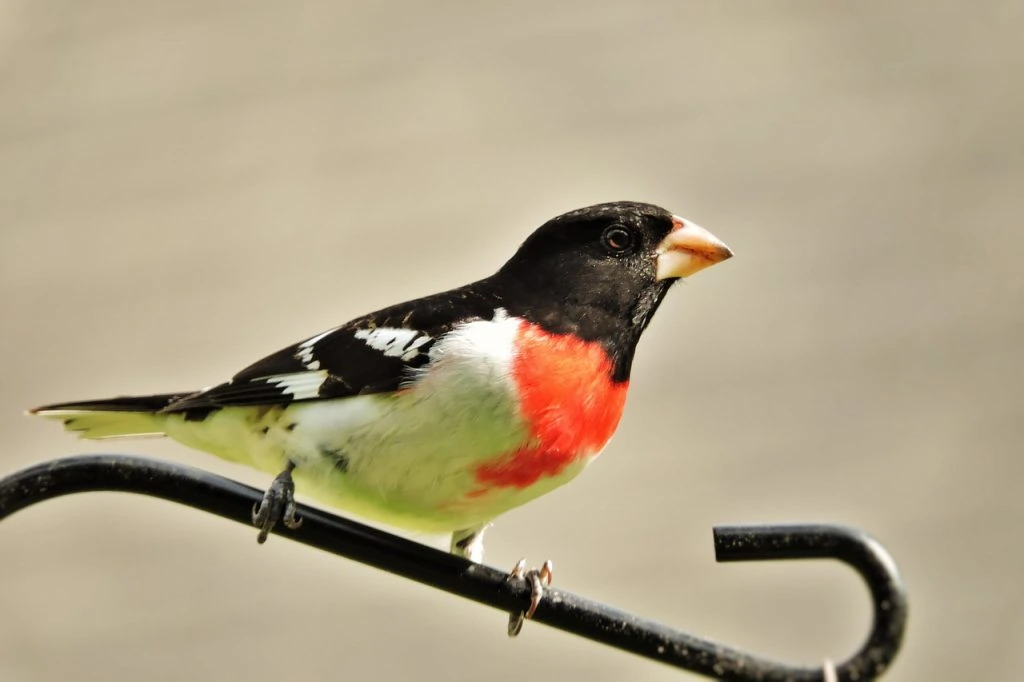
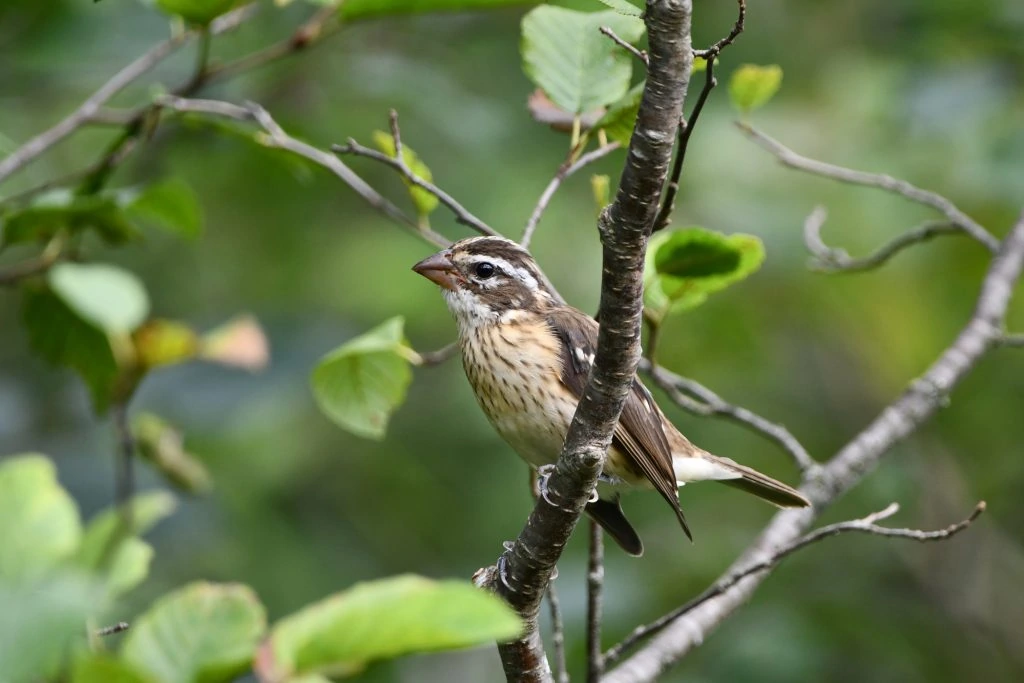
Rose-breasted Grosbeaks are usually spotted in Texas during migration from April to May and in October. They are recorded in 13% of checklists during spring and 1% of checklists during fall.
Female Rose-breasted Grosbeaks and immature males are brown with lots of streaking and a flash of yellow under the wings.
Rose-breasted Grosbeaks males are black-and-white birds with black heads and backs, white bellies, and red breasts. They also have a flash of red under their wings.
- Pheucticus ludovicianus
- Length: 7.1-8.3 in (18-21 cm)
- Weight: 1.4-1.7 oz (39-49 g)
- Wingspan: 11.4-13.0 in (29-33 cm)
Rose-breasted Grosbeaks breed in northeastern US states, the Midwest, and southern and central Canada. They can be seen during migration in southeastern US states. Winter is spent in Mexico, Central America, and the Caribbean.
You can find Rose-breasted Grosbeaks in forests, parks, and backyards foraging for insects, berries, and seeds.
Nests of Rose-breasted Grosbeaks are placed in the branches of a low tree. They are made of loosely-formed twigs, grass, and plants. There are about five eggs that take two weeks to hatch. After that, both parents take turns incubating the eggs.
Attract Rose-breasted Grosbeaks to your backyard with sunflower seeds and peanuts.
29. Canyon Towhee
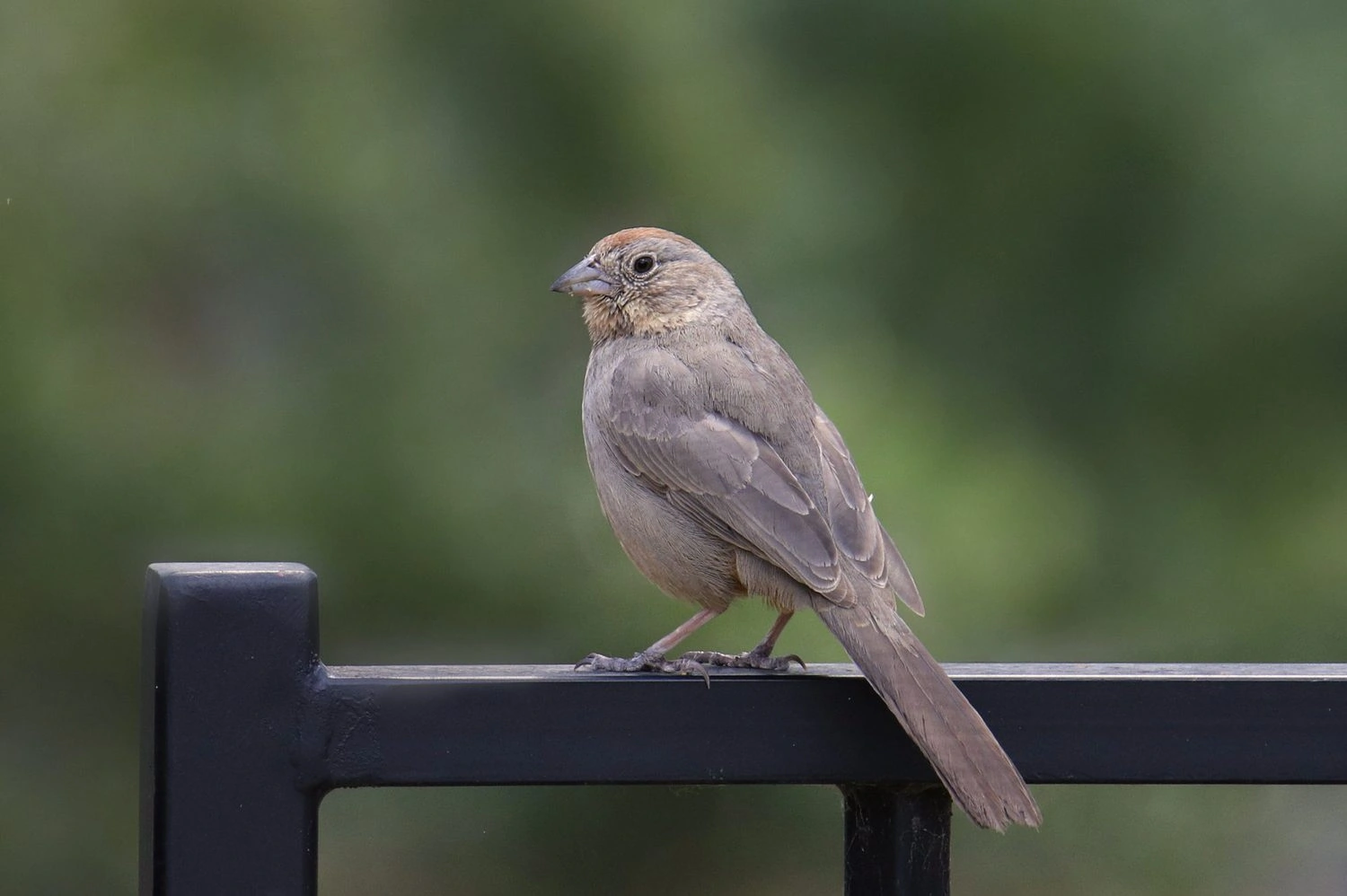
Canyon Towhees do not migrate and are residents all year in Texas. They are spotted in up to 2% of summer and winter checklists.
Canyon Towhees are plain grayish-brown sparrows with long tails and plump bodies. Although they look similar to California Towhees, their range does not overlap.
- Melozone fusca
- Length: 8.3-9.8 in (21-25 cm)
- Weight: 1.3-1.9 oz (37-53 g)
- Wingspan: 11.5 in (29.21 cm)
Canyon Towhees are resident all year in southwestern US states and Mexico. You can find Canyon Towhees on the ground in desert grassland, foraging mainly for seeds and berries. However, they will also eat some grasshoppers and other insects.
Nests of Canyon Towhees are placed near the trunk of trees and large shrubs, so they are well supported and hidden. The nest is made by the female from grass and plant material and is lined with soft grass and animal hair.
Attract Canyon Towhees to your backyard with black oil sunflower seeds, milo, millet, and oats scattered on the ground. However, they are shy birds that can be hard to attract.
30. Northern Waterthrush
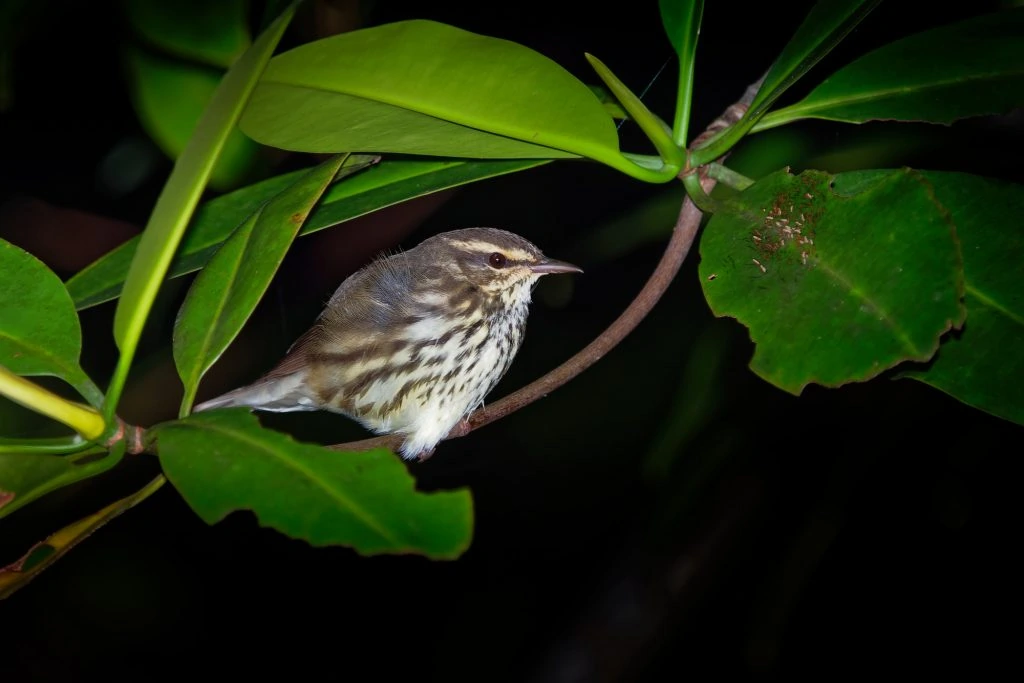
Northern Waterthrushes are usually spotted in Texas during migration, especially from April to May and September to October. They are recorded in 7% of checklists during spring and 2% of checklists during fall.
Northern Waterthrushes are large, thrush-like birds. Males and females both bear similar traits. They both have brown heads with thick, white eyebrows, dark brown backs, and white bellies with dark, heavy streaking from their throats all the way to their rumps.
- Parkesia noveboracensis
- Length: 5.75 inches (15 cm)
- Weight: 0.8 oz (23 g)
- Wingspan: 8.75 inches (22 cm)
Northern Waterthrushes breed in Canada, Alaska, and northeastern US states before migrating to Mexico, Central and South America, and the Caribbean. Some may remain all year in Central and South America.
You can find Northern Waterthrushes in dark, woody swamps, thickets, and bogs. If there is any still or sluggish water in the forests, you’ll probably find a Northern Waterthrush around it. In winter, in the tropics, you will usually find them among mangroves.
The Northern Waterthrushes are aquatic and terrestrial foragers. With their long legs, they can walk on shallow water in search of water beetles, mosquitoes, slugs, crustaceans, snails, and sometimes, small fish. They also eat caterpillars, moths, and ants, which they find under leaves.
Nests of Northern Waterthrushes are usually located in hollows or crevices near water. They can be in a moss-covered stump or under a jutting bank, but the nests are usually hidden among ferns.
31. Wood Thrush
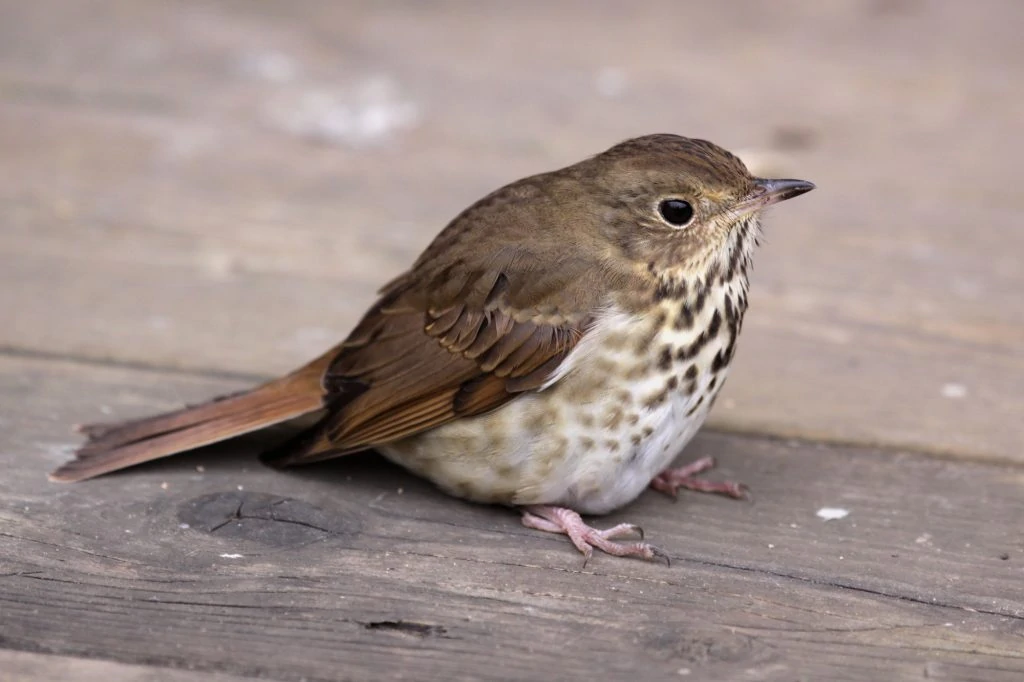
Wood Thrushes can be spotted migrating mainly in eastern Texas from April to June and October to November.
Wood Thrushes’ plump white and black-spotted bellies give them a slightly comical appearance. They are brown on the back and have reddish colors on the crown and upper back.
- Hylocichla mustelina
- Length: 7.5-8.3 in (19-21 cm)
- Weight: 1.4-1.8 oz (40-50 g)
- Wingspan: 11.8-13.4 in (30-34 cm)
Wood Thrushes migrate from eastern US states across the Gulf of Mexico into Central America in one night.
These birds stay hidden, foraging in leaf litter for insects, such as beetles and flies, in mature forests. In spring, they can be heard making a ‘flute-like’ song.
32. Brown Creeper
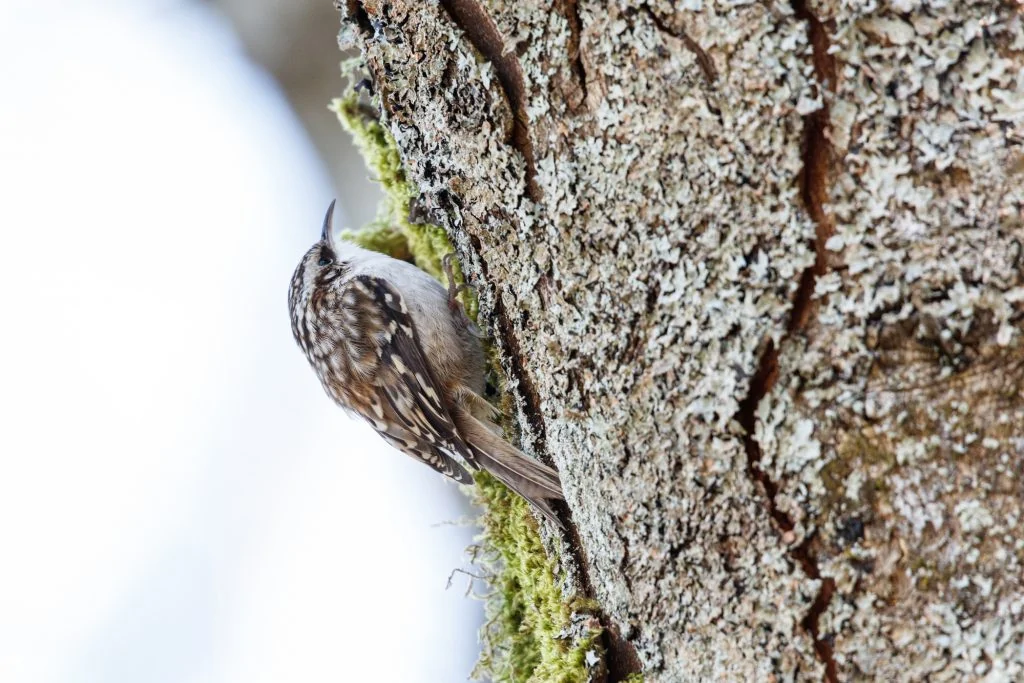
Brown Creepers are mainly spotted in Texas from mid-October to March and are recorded in 1% of winter checklists.
Brown Creepers are tiny songbirds that are hard to spot against tree trunks, with their streaked brown backs and white undersides.
- Certhia americana
- Length: 4.7-5.5 in (12-14 cm)
- Weight: 0.2-0.3 oz (5-10 g)
- Wingspan: 6.7-7.9 in (17-20 cm)
Brown Creepers do not migrate, but they can move south and from higher elevations in winter. They can be found in Alaska, southern Canada, northeastern and eastern US states, and down to Mexico and Central America. They also move into central and southeastern states in some winters.
To spot one of these tiny birds, look closely at tree trunks of mature woodland with large trees where you may find them hunting for insects and larvae hidden in the bark.
Brown Creepers are usually found working their way up the tree and so face upwards, unlike nuthatches which face down the tree trunk.
33. Louisiana Waterthrush
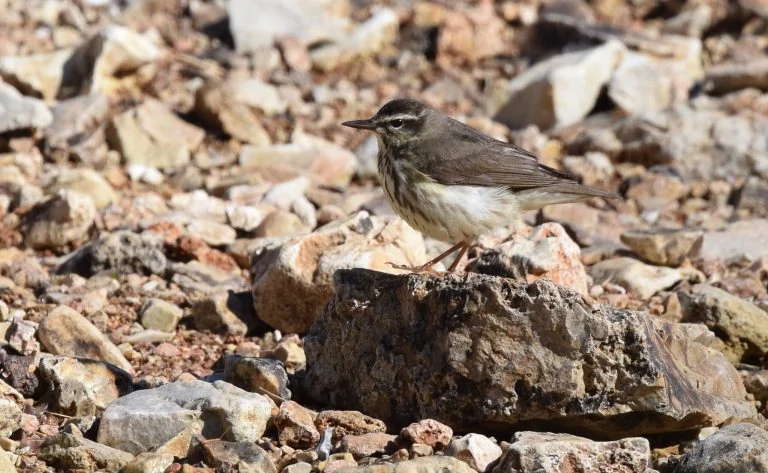
Credit: Andy Reago & Chrissy McClarren
Although some can be spotted here all year, Louisiana Waterthrushes are most likey to be spotted migrating across Texas from March to May and mid-July to August.
Louisiana Waterthrushes are drab in comparison to other warblers. They are brown on top and pale below. They have a white eyebrow stripe and long pink legs.
- Parkesia motacilla
- Length: 5.9-6.1 in (15-15.5 cm)
- Weight: 0.6-0.8 oz (18.2-22.9 g)
- Wingspan: 9.4-10.6 in (24-27 cm)
Louisiana Waterthrush breed in eastern US states and can be seen in the southeast during migration. They spend the winter in Mexico, Central America, and the Caribbean, arriving back in spring early in the year.
You can find Louisiana Waterthrush along streams and moving water in woodlands hunting for insects, vertebrates, and larvae.
Nests of Louisiana Waterthrush are along the bank of a stream and hidden in roots or under logs. The nest is made from leaves, pine needles, and other plant material and is held together with mud.
34. Winter Wren
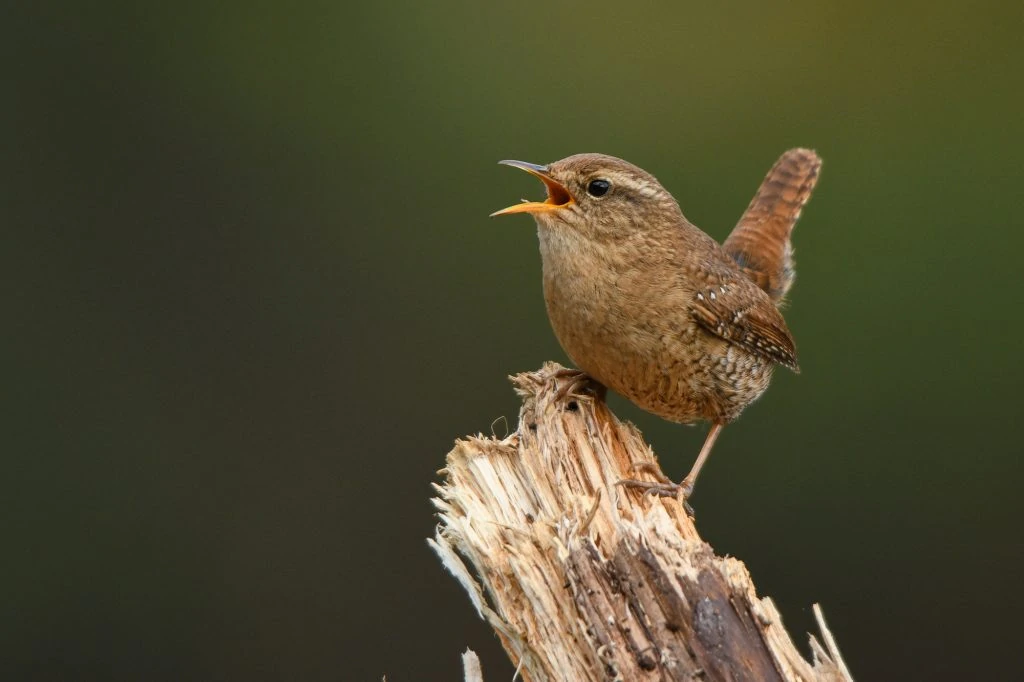
Winter Wrens can be spotted in Texas during winter and occur in 1% of checklists. They are seen in the state from September to May.
Winter Wrens are small, plump brown birds with darker barring on the wings, tail, and belly. They have a paler eyebrow stripe and short tails, which they keep upright. Males and females look the same.
Winter Wrens look very similar to Pacific Wrens, and there were once thought to be the same species, but now they are classed as different, and they sing different songs.
- Troglodytes hiemalis
- Length: 3.1-4.7 in (8-12 cm)
- Weight: 0.3-0.4 oz (8-12 g)
- Wingspan: 4.7-6.3 in (12-16 cm)
Winter Wrens are found in eastern US states in winter and northeastern US states, and Canada in summer.
Look for Winter Wrens hidden in tangled undergrowth in forests and backyards. They eat insects and spiders by rummaging through fallen leaves and decaying bark.
Nests of Winter Wrens are made of twigs, moss, and grass woven together into a round shape with a small opening. They lay 1 – 9 eggs, and hatching takes around two or two and a half weeks and fledging the same.
Attract Winter Wrens to your backyard with native plants and dense vegetation.
35. Eastern Towhee
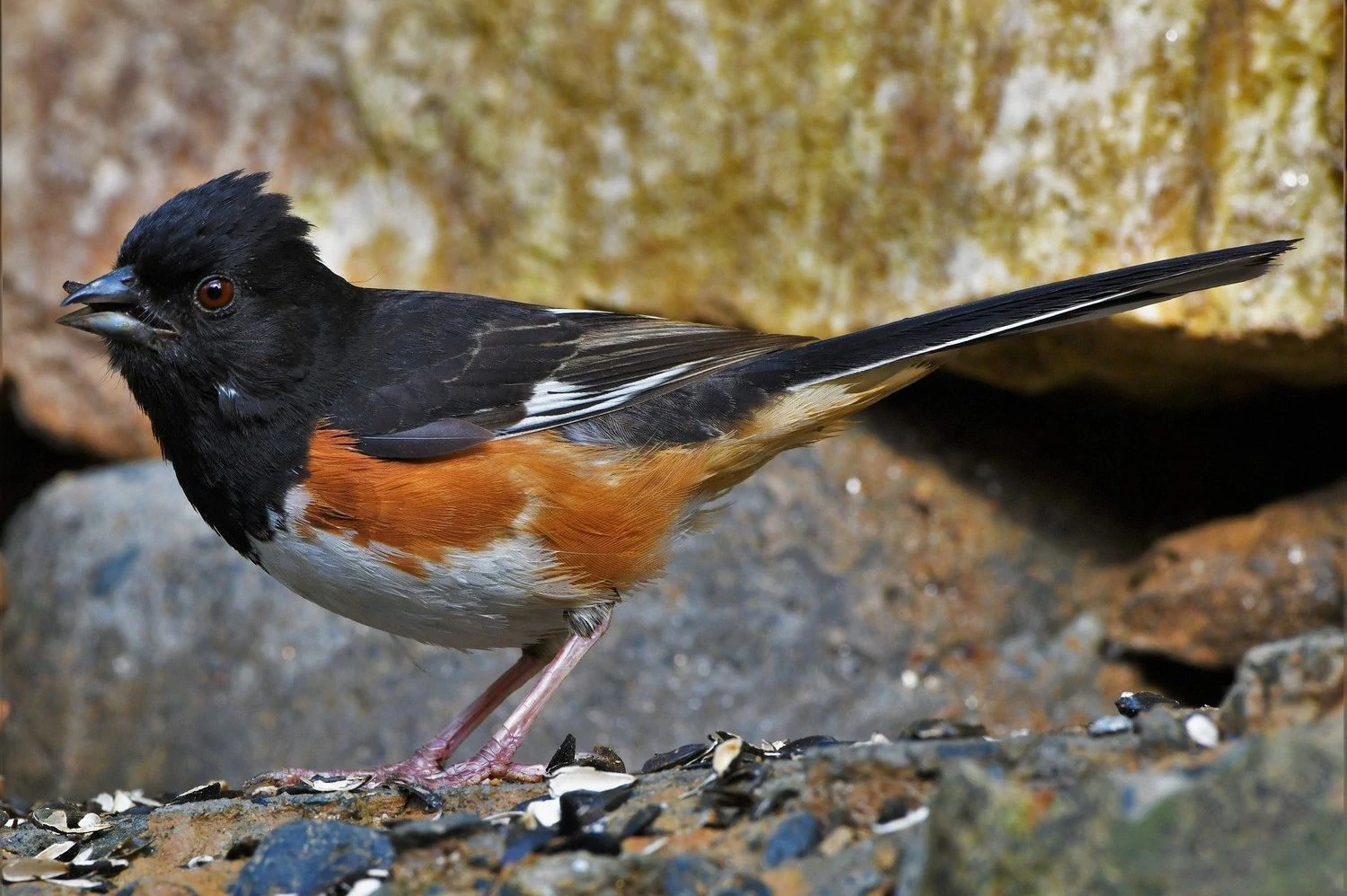
Eastern Towhees are winter birds in Texas and are mostly spotted from November to April in the east of the state.
Eastern Towhees are striking large sparrows, about the size of Robin, with a black head, throat, and back, reddish sides, long tails, and a white belly in the males. Females are similar but brown instead of black.
- Pipilo erythrophthalmus
- Length: 6.8-8.2 in (17.3-20.8 cm)
- Weight: 1.1-1.8 oz (32-52 g)
- Wingspan: 7.9-11.0 in (20-28 cm)
Eastern Towhees live all year in southeastern US States, but birds further north move south for the winter.
You can find Eastern Towhees rummaging in the undergrowth and along the edges of forests and thickets.
Eastern Towhee sounds: Their song is a sharp note, followed by a trill.
Nests of Eastern Towhees are usually on the ground, hidden in fallen leaves. They are made from twigs, bark, and leaves, lined with soft grass and animal hair. They lay up to six eggs, which take just under two weeks to hatch and the same for young to fledge.
Attract Eastern Towhees to your backyard with overgrown borders and platform feeders with black oil sunflower seeds, hulled sunflower seeds, cracked corn, and millet.
Fun fact: Eastern Towhees love the sun and will be found on south-facing slopes.
36. Purple Finch – Female
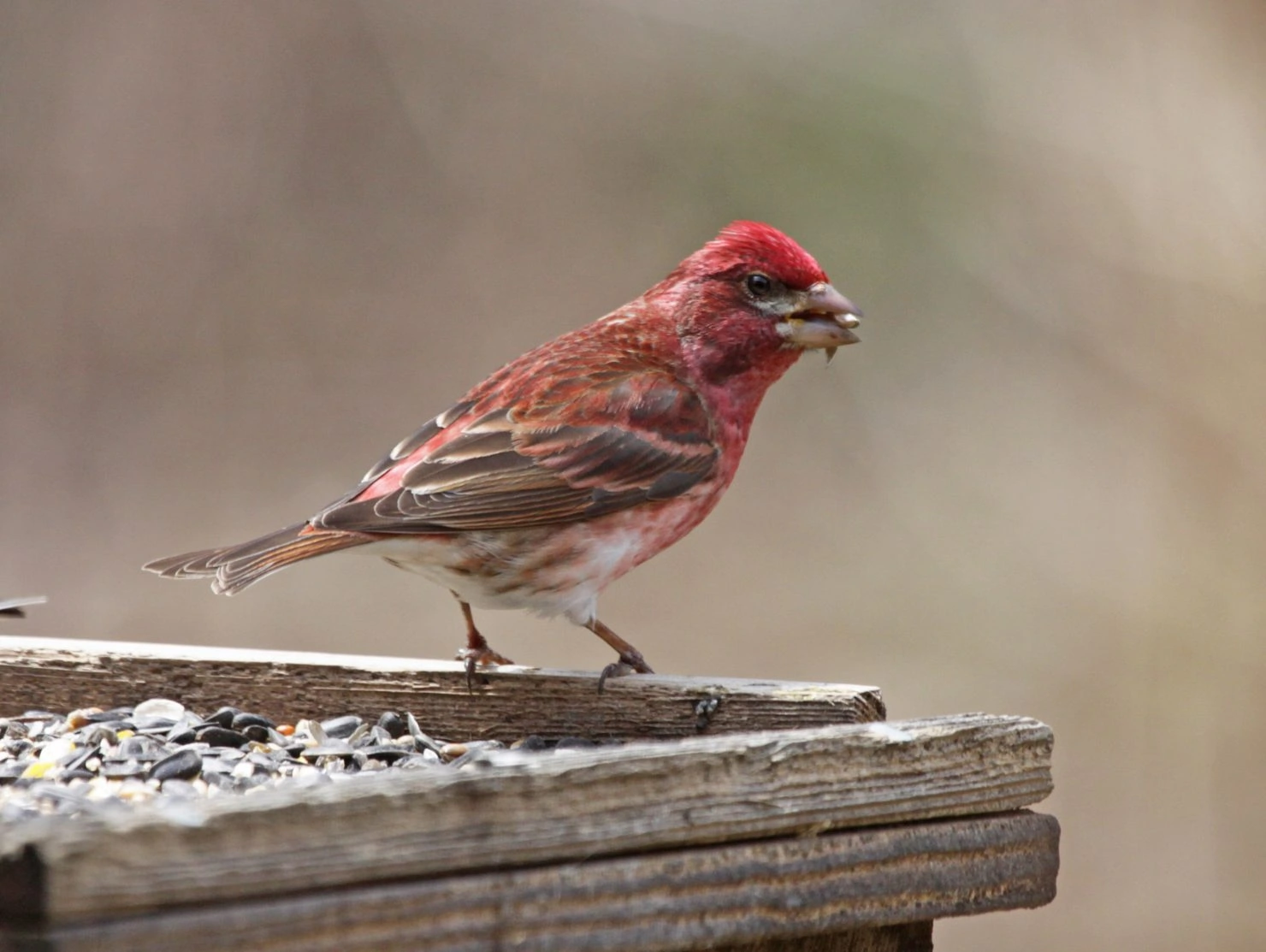
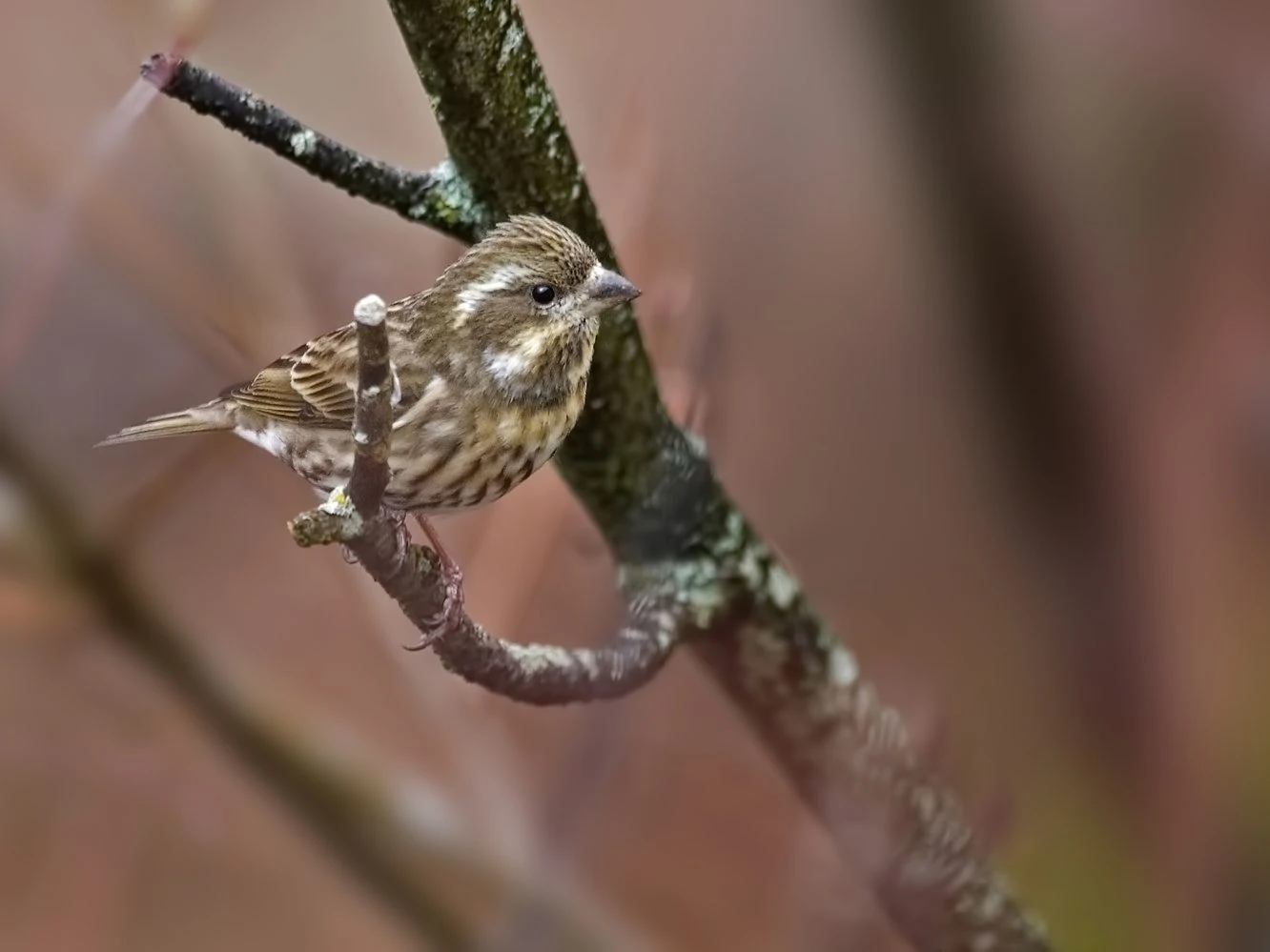
Purple Finches are winter birds in Texas and are mainly spotted here from mid-November to March in the east of the state. They are recorded in 1% of winter checklists.
Female Purple Finches are brown-streaked all over, but males have reddish-purple heads and breasts with more brown on the back and wings and have a paler belly. They look very similar to House Finch but are redder, especially at the top of their back.
- Haemorhous purpureus
- Length: 4.7-6.3 in (12-16 cm)
- Weight: 0.6-1.1 oz (18-32 g)
- Wingspan: 8.7-10.2 in (22-26 cm)
Purple Finches breed in Canada and overwinter in eastern US states but can be found all year in the north-east and Pacific coast.
You can find Purple Finch in evergreen forests feeding on seeds but also buds, nectar, and berries.
Nests of Purple Finches are located high up in trees. They are made of twigs, barks, weeds, and moss. They usually hold three to five eggs that are incubated for thirteen days by the female.
Attract Purple Finches to your backyard with black oil sunflower seeds.
37. Golden-crowned Sparrow
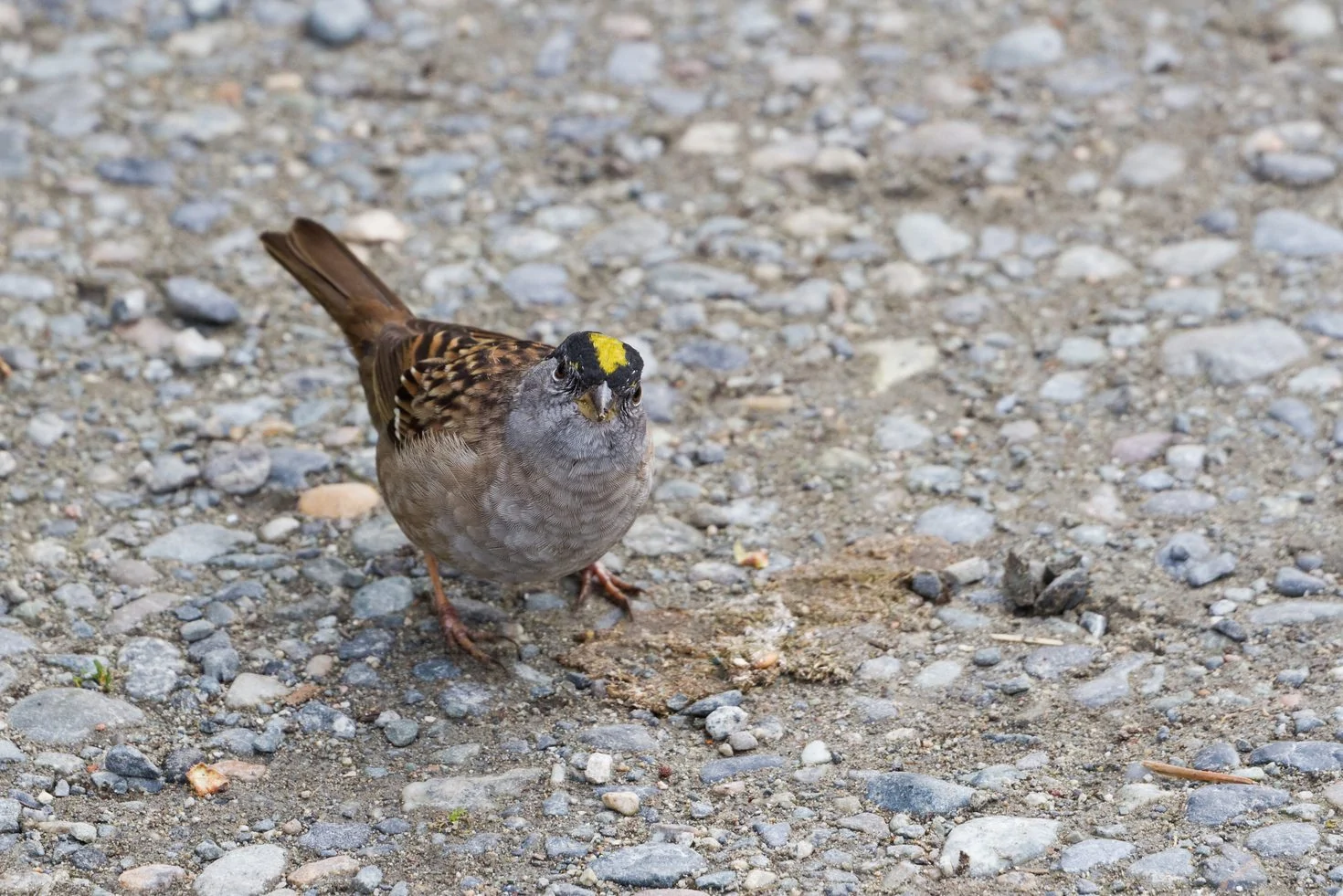
Golden-crowned Sparrows are considered rare or accidental species in Texas, but they can occasionally be spotted here during winter.
Golden-crowned Sparrows are grayish-brown underneath and streaked brown on the back. Their heads have a black crown and a bright-yellow forehead.
Their colors are duller and brown on the crown in winter, and the yellow forehead is also duller.
- Zonotrichia atricapilla
- Length: 5.9-7.1 in (15-18 cm)
- Weight: 1.1-1.2 oz (30-33 g)
Golden-crowned Sparrows breed in Alaska and western Canada before migrating to the West Coast for winter.
You can find Golden-crowned Sparrow in weedy fields scratching for seeds such as dock, sumac, and geranium. They also eat fruit such as apples, grapes, elderberry, and olives. Insects, such as ants, beetles, butterflies, and termites also make up some of their diets.
Nests of Golden-crowned Sparrows are usually on the ground and made from twigs, moss, and leaves. They are lined with softer materials, such as animal hair, grass, and feathers.
Attract Golden-crowned Sparrows to your backyard with seeds on ground feeders or plant native plants that fruit.
38. American Tree Sparrow
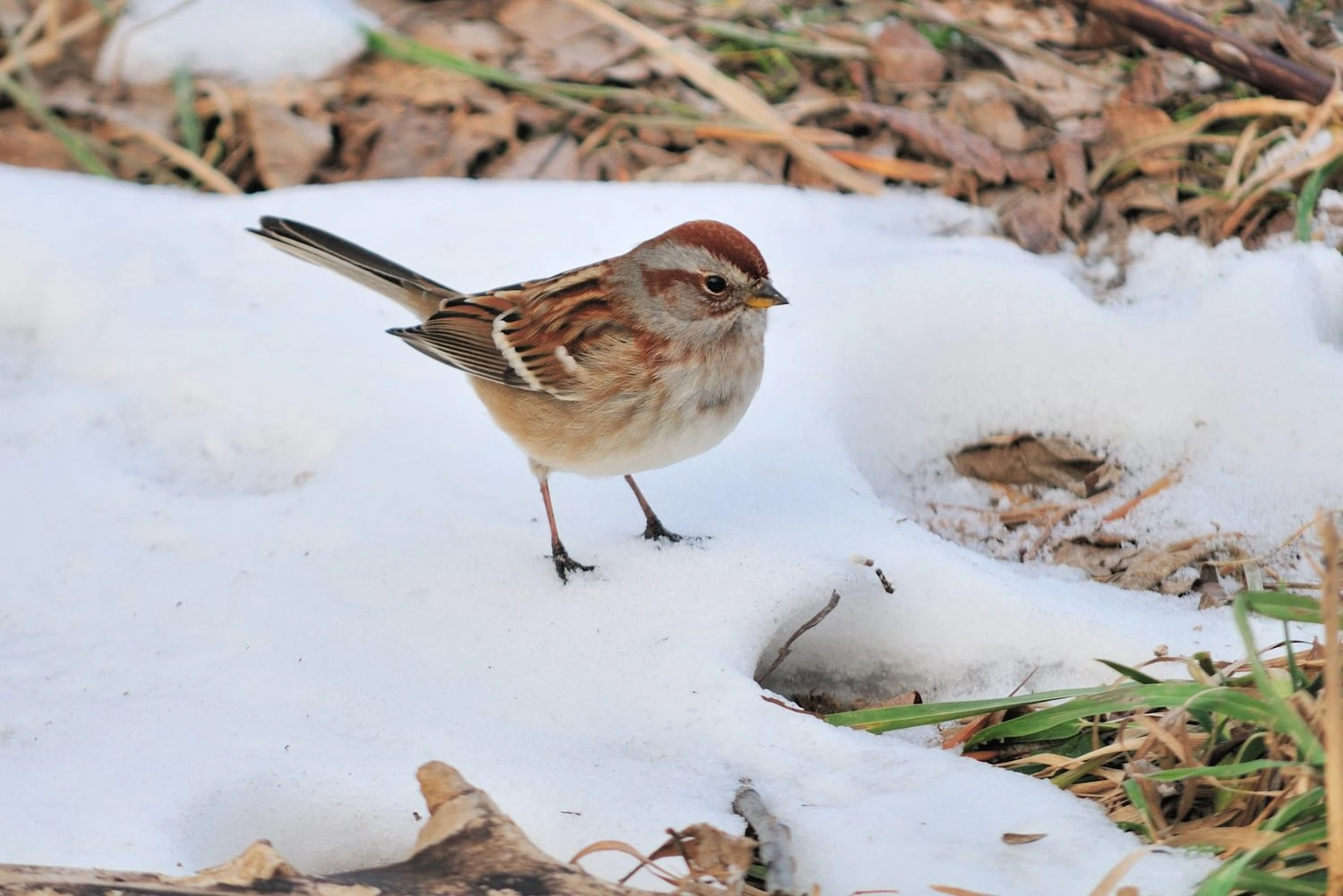
American Tree Sparrows are extremely rare to find in Texas, but there have been sightings here during winter, mostly in the north of the state.
American Tree sparrows are long-tailed brown-streaked plump birds with rusty caps, gray faces, and a rusty eye line.
- Spizelloides arborea
- Length: 5.5 in (14 cm)
- Weight: 0.5-1.0 oz (13-28 g)
- Wingspan: 9.4 in (24 cm)
American Tree Sparrows are a bird of winter in the US and a bird of summer in Canada. They breed in the far north of Canada and in Alaska and migrate to most US states for the winter, except along the Pacific and Gulf Coasts.
You can find American Tree Sparrows foraging in small flocks in weedy fields and under bird feeders.
Nests of American Tree Sparrows’ are usually on or near to the ground and are made of twigs, grass, and moss. They lay around five eggs, and these take just under two weeks to hatch and just over a week for the young to fledge.
Attract American Tree Sparrows to your backyard platform feeders with black oil sunflower seeds, nyjer, cracked corn, and millet. They also feed on seeds dropped on the ground from tube feeders.
How Frequently Brown Birds Are Spotted In Texas In Summer And Winter
Checklists are a great resource to find out which birds are commonly spotted in your state. These lists show which brown birds are most frequently recorded on checklists on ebird in summer and winter in Texas.
Brown Birds in Texas in summer:
Northern Cardinal 55.2%
Mourning Dove 44.4%
House Sparrow 28.7%
Carolina Wren 28.3%
House Finch 21.4%
Brown-headed Cowbird 17.9%
Bewick’s Wren 12.4%
Eastern Phoebe 10.8%
Great Crested Flycatcher 9.1%
American Robin 8.1%
Common Yellowthroat 5.5%
Cedar Waxwing 3.6%
Swainson’s Thrush 3.4%
Chipping Sparrow 3.2%
Canyon Towhee 2.3%
Rose-breasted Grosbeak 2.0%
Brown Thrasher 1.7%
Northern Waterthrush 1.4%
White-crowned Sparrow 1.3%
Savannah Sparrow 1.1%
Pine Siskin 1.0%
Wood Thrush 0.8%
Spotted Towhee 0.7%
American Goldfinch 0.6%
Northern Flicker 0.5%
House Wren 0.5%
Marsh Wren 0.5%
Louisiana Waterthrush 0.4%
Hermit Thrush 0.4%
White-throated Sparrow 0.2%
Swamp Sparrow <0.1%
Eastern Towhee <0.1%
Brown Creeper <0.1%
Song Sparrow <0.1%
Golden-crowned Sparrow <0.1%
Winter Wren <0.1%
Purple Finch <0.1%
American Tree Sparrow <0.1%
Brown Birds in Texas in winter:
Northern Cardinal 48.5%
Mourning Dove 28.2%
Eastern Phoebe 25.9%
Carolina Wren 24.2%
House Sparrow 21.1%
American Goldfinch 19.7%
American Robin 17.3%
House Finch 15.9%
Savannah Sparrow 13.8%
Cedar Waxwing 12.4%
Chipping Sparrow 12.1%
White-throated Sparrow 10.8%
White-crowned Sparrow 9.6%
Bewick’s Wren 8.7%
Song Sparrow 8.4%
House Wren 7.5%
Northern Flicker 7.4%
Brown-headed Cowbird 5.8%
Hermit Thrush 5.7%
Common Yellowthroat 5.5%
Pine Siskin 5.5%
Spotted Towhee 4.1%
Swamp Sparrow 4.0%
Brown Thrasher 2.9%
Marsh Wren 2.7%
Brown Creeper 1.7%
Winter Wren 1.4%
Canyon Towhee 1.0%
Purple Finch 1.0%
Eastern Towhee 0.8%
Northern Waterthrush 0.1%
Rose-breasted Grosbeak <0.1%
American Tree Sparrow <0.1%
Golden-crowned Sparrow <0.1%
Wood Thrush <0.1%
Louisiana Waterthrush <0.1%
Great Crested Flycatcher <0.1%
Swainson’s Thrush <0.1%

